 |
PO
Box 9021, Wilmington, DE 19809, USA
E-mail: font@focusonnature.com
Phone: Toll-free in USA 1-888-721-3555
or 302/529-1876 |
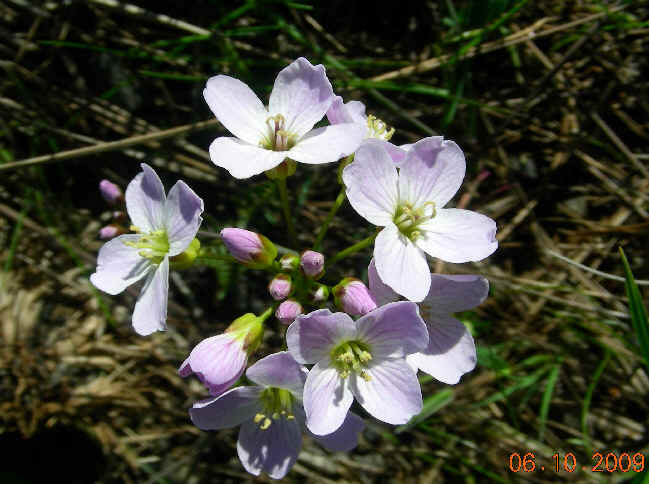 Wildflowers
Wildflowers
and some other plants
in Northern Places
such as Alaska
and Iceland
and including alpine plants
of Hokkaido
in Japan
with those during
Focus On Nature Tours
noted with an (*)
1996 thru 2015
during tours in the months of May, June, September,
and October
In this list, there
are notes relating to
MEDICINAL PLANTS.
An excellent book, and
a source of some of the information in this list, is "Medicinal Plants of Iceland" by
Arnbjorg Linda Johannsdottir.
The compilation of the following list
of plants of Alaska, Iceland, and Hokkaido, Japan by Armas Hill
Photo at upper right: In Iceland, EUROPEAN CARDAMINE, Cardamine pratensis
angustifolia,
formerly LADY SMOCK, Cardamine nymanii (photograph by Gerin Hood)
Many of the photos below were taken during the June 2009 FONT Iceland Tour by participant, Gerin Hood.
And she also took the time to do many of the
identifications. Thanks Gerin!
A fine book about the plant life of Iceland is "A Guide to the Flowering
Plants & Ferns of Iceland" by Hordur Kristinsson, published in 1986.
There is a version in English.
A fine book about wildflowers and other plant life in Alaska is a "Field
Guide to Alaskan Wildflowers", by Verna Pratt, published in 1989.
Again, this book is a source of some of the information in this list, as are the
other books noted here.
Line drawings with this list are from another good book, "Wild Plants of
America: A Select Guide for the Naturalist and Traveler", by Richard M.
Smith, published in 1989.
Another source for some information in this list is the book, "Medicinal
Plants of Iceland", by Arnbjorg Linda Johannsdottir, published in 2012.
The book "Alpine Flowers of Hokkaido" has many wonderful
photographs. But in it there is not a word in English. Nor, in English, is there
a name of an author. There are scientific names of the plants in
Latin.
There have been 19, nearly 20 FONT
tours in Iceland. And nearly 10 FONT tours in Alaska.
Also, since 1990, there have been 37 FONT tours in Japan, with about half of
them in Hokkaido.
Among the Plant
Families in this list, links to these:
Adder's-tongue
(or Moonwort)
Algae Arrow-grass Arum (or Calla)
Barberry Beech-fern
Bellflower
(or Bluebell) Birch
Birchroot
Bladderwort (or Birthwort) Bogbean
Borage
Broomrape
Buckthorn Bunchflower Bur-reed Buttercup (or
Crowfoot) Clubmoss
Crowberry Cypress
Daisy (or Aster) Diapensia Dock (or Buckwheat, Knotweed) Dogbane
Dogwood Earthsmoke (or Fumitory) Eel-grass Fern &
Hard-fern Figwort (or Snapdragon)
Flax Gentian Geranium Ginseng Gooseberry Goosefoot
Grass Heath
Holly Honeysuckle
Horsetail Hydrangea Iris Ivy Lady-fern Legume (or Pea) Lily
Madder (or Bedstraw)
Mare's-tail
Mint Mountain Parsley (or
Parsley Fern, Rockbrake) Mustard Nettle Oleaster
Orchid
Parnassus-grass Parsley (or Celery) Peony Phlox (or Polemonium) Pine
Pink (or
Carnation) Plantain Polypod Ferns Polypody
Pondweed Poppy Primrose
Purslane Quillwort Rose
Rush Sandlewood Saxifrage Sea Lavender
Sedge
In the SEDGES: Eriophorum
scheuchzeri, Alaska Cotton, or in Iceland called Hrafnafifa.
Snakeberry Soapberry
Spikemoss Spleenwort Spurge Staff-vine (or
Bittersweet) Starwort
St Johns Wort Stonecrop
Sundew Teasel
Valerian Violet Water Lily Water-milfoil Willow
Willow Herb (or Evening Primrose) Wintergreen Wood-sorrel
AN
ALPHABETICAL DIRECTORY OF PLANT GENERA IN THIS WEBSITE NOTING FAMILIES
Additional Links:
Upcoming
FONT Birding & Nature Tours in:
Alaska
Iceland
Japan
Elsewhere
Birds
during FONT Iceland Tours Birds
during FONT Alaska Tours
Birds during FONT Japan Tours, in a list with photos in 2 parts
Other
Lists and Photo Galleries in this website relating to Plants:
Alaska Wildflowers (a
list grouped by color) Iceland Wildflowers (a list
grouped by color)
Texas Wildflowers (a list grouped by families)
Desert
Plants of the Southwest US and Northern Mexico
Tropical
Plants in the Americas (in two parts, including the Caribbean, Mexico, Central and
South America)
Plants of the West
Indies Fruiting Plants and Others in Brazil
Wild Orchids in the Americas
Wildflowers and Other Plants of the Mid-Atlantic Region of Eastern North
America

Codes:
AK: occurs in Alaska
HK: occurs in Hokkaido, Japan (as an alpine plant)
IC: occurs in Iceland
(ph): species with a photo or drawing in the FONT website
Numbers noted as (NW:xx)
refer to pages with photos in the "National Wildlife
Federation Field Guide to Wildflowers of North America" by David
Brandenburg, 2010
Numbers noted as (ST:xx) refer to pages with
an illustration in "The Sibley Guide to Trees" by David Sibley,
2009.
A List of Northern
Wildflowers and some Other Plants:
Adder's-tongue, or
Moonwort Family , OPHIOGLOSSACEAE
- Northern Moonwort ______ IC
Botrychium boreale
- Lance-leaved Moonwort ______ IC
Botrycjium lanceolatum
- Common Moonwort ______ HK
IC
Botrychium lunaria
- Glossy Moonwort ______ IC
Botrychium simplex
- Small Adder's-tongue ______
IC(very rare)
Ophioglossum
azoricum
Algae Family, FUCACEAE
- Bladderwrack (or Black Tang) ______ IC
Fucus vesiculosus
Bladderwrack grows on rocky beaches. In Iceland, it is common
along such coastlines.
MEDICINAL USE:
the entire plant
Kelp tablets are available in health food stores and some pharmacies.
Active substances are mucrilage, mannitol, fucosterin, fucoxanthin, sisantin,
volatile oils and many minerals such as iodine.
Bladderwrack is used to treat an
underactive thyroid gland (goitre). It is also useful for chronic fatigue
and tiredness.
Bladderwrack poultices are good for swollen joints and muscles.
Arrow-grass Family,
JUNCAGINACEAE
- Sea Arrow-grass ______ IC
Triglochin maritima
- Marsh Arrow-grass ______ IC
Triglochin palustris
Arum,
or Calla Family,
ARACEAE
also called
AROIDS
- Wild Calla ______ AK
(NW:73)
Calla palustris
Another name for Calla
palustris is Water Arum.
The entire plant of the Wild
Calla is poisonous, especially the berries.
- Lysichiton
camtschatcense ______ HK
- Skunk-cabbage (ph) ______ HK
(NW:75)
Symplocarpus foetidus
(var. latissima)
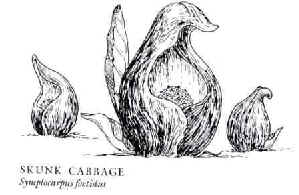
Above & below: Skunk-cabbage
(photo below by Rise Hill)
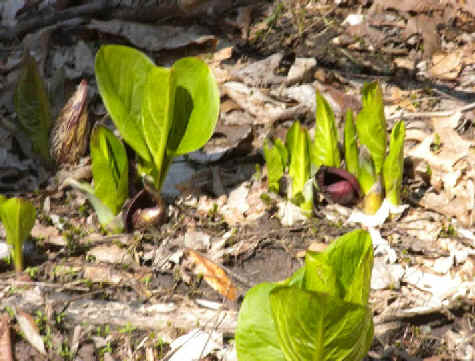
Barberry Family,
BERBERIDACEAE
- Berberis amurensis
______ HK
- Diphylleia grayi
______ HK
Beech-fern, or Maiden Fern Family, THELYPTERIDACEAE
- Beech Fern ______
IC
Thelypteris phegopteris
- Thelypteris
quelpaertensis ______ HK
Bellflower, or
Bluebell Family, CAMPANULACEAE
- Adenophora
nikoensis (var. petrophila) ______
HK
- Adenophora
pereskiifolia ______ HK
Adenophora pereskiifolia heterotricha ______
HK
- Adenophora triphylla
(var. hakusanensis) ______ HK
Adenophora triphylla (var. japonica) ______ HK
- Adenophora uryuensis
______ HK
- Campanula aurita ______
AK
- Campanula chamissonis
______ HK
- Mountain Harebell ______ AK
HK
Campanula lasiocarpa
- Common Harebell (or Bluebells of
Scotland) ______ AK IC
(NW:184)
Campanula rotundifolia
- Arctic Harebell ______ AK IC (NW:185)
Campanula uniflora
Another name for Campanula
uniflora is Arctic Bellflower.
- Lobelia sessilifolia
______ HK
- Peracarpa carnosa
______ HK
- Platycodon grandiflorus
______ HK
Birch Family, BETULACEAE
- Speckled Alder (*) ______
AK (ST:162)
Alnus incana
- Green Alder (*) ______ AK
(ST:163)
Alnus viridis
Alnus viridis maximowiczii ______ HK
Other names for Alnus viridis
are Mountain Alder, Sitka Alder, Siberian Alder.
- Betula apoiensis ______
HK
- Betula ermannii
______ HK
- Kenai Birch (*) ______
AK (ST:152)
Betula kenaica
- Dwarf Birch ______ IC
Betula nana
- Resin Birch ______ AK
(ST:152)
Betula neoalaskana
- Paper Birch ______ AK
(ST:151)
Betula papyrifera
- Downy Birch (*) ______
IC (ST:155)
Betula pubescens
Other names for Betula pubescens
are European White Birch and Hairy Birch.
Birchroot Family, MELANTHIACEAE
- Herb-Paris ______
IC(rare)
Paris
quadrifolia
Bladderwort,
or Birthwort Family,
LENTIBULARIACEAE
- Common Butterwort (ph)
______ HK IC(*) (NW:296)
Pinguicula vulgaris
Pinguicula vulgaris (var. macroceras) ______ HK
In Iceland, the Common Butterwort is common
throughout. It grows in peat bogs and marshlands.
Common Butterwort was used, in the past, for making Icelandic skyr,
and therefore has also been called the "curdle herb".
The plant is carnivorous, catching and digesting small insects.
MEDICINAL USE: the leaves.
The Common Butterwort has been used successfully to treat whooping
cough. Still, the herb can be used for dry, tickling coughs and persistent
coughing attacks.
The leaves are good for placing on bad sores, inflammation or cracked skin,
and have been used to kill lice on the scalp.
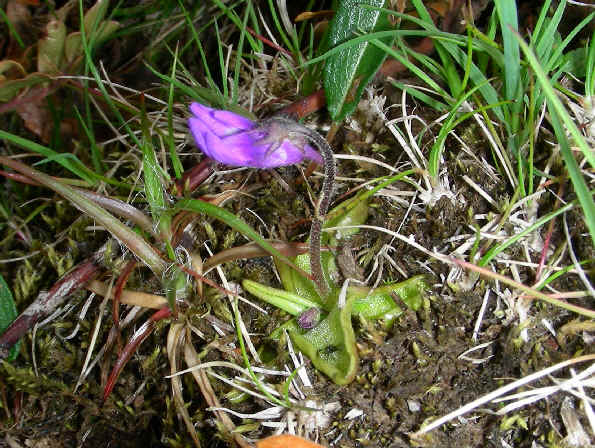
Common Butterwort
(photo courtesy of Gerin Hood, during the
FONT June 2009 Iceland tour)
- Lesser Bladderwort ______ IC
Utricularia minor
Bogbean Family, MENYANTHACEAE
- Bogbean
______ AK HK IC
(NW:348)
Menyanthes trifoliata
Another name for Menyanthes trifoliata
is Buckbean.
- Nephrophyllidium
crista-galli japonicum ______ HK
Borage Family, BORAGINACEAE
- Eritrichium nipponicum (var.
albiflorum) ______ HK
- Oysterplant (ph) ______
IC(*)
Mertensia maritima
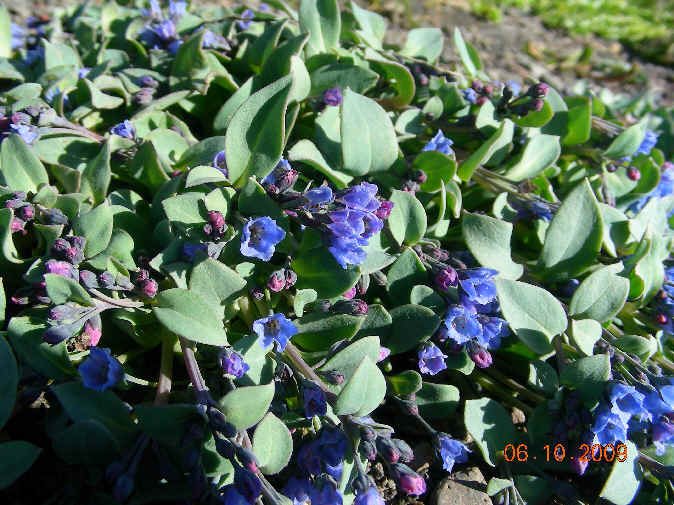
Oysterplant
(photo courtesy of Gerin Hood, during the FONT June 2009
Iceland tour)
- Bluebells ______
AK
Mertensia paniculata
Other names for Mertensia paniculata are:
Lungwort, Languid Lady, Chiming
Bells
- Mertensia pterocarpa (var. yesoensis)
______ HK
- Alpine Forget-me-not ______ AK
Myosotis alpestris asiatica
- Field Forget-me-not ______ IC
Myosotis arvensis
- Yellow-and-blue Forget-me-not ______
IC (NW:573)
Myosotis discolor
Another name for Myosotis
arvensis is Changing Forget-me-not. In Iceland, it is a rare alien in the south and southwest.
- Water Forget-me-not ______
IC (NW:158)
Myosotis scorpioides
Myosotis scorpioides
is also called the European
True Forget-me-not.
- Strict Forget-me-not ______ IC
Myosotis stricta
- Myosotis sylvatica
______ HK
- Brook
Forget-me-not ______ AK
Myosotis palustris
In Alaska, the Brook Forget-me-not is an introduced species.
Broomrape Family,
OROBANCHACEAE
- Broomrape (or Ground Cone)
______ AK HK
Boschniakia rossica
Buckthorn Family, RHAMNACEAE
- Rhamnus ishidae
______ HK
Bunchflower Family, TOFIELDIA
- Tofieldia coccinea ______
HK
Tofieldia coccinea (var. kondoi) ______ HK
- Tofieldia okuboi ______
HK
- Scottish Asphodel ______
IC
Tofieldia pusilla
Bur-reed Family, was
SPARRGANIACEAE, now in TYPHACEAE
- Floating Bur-reed ______ HK
IC
Sparganium
angustifolium
- Sparganium glomeratum
______ HK
- Sparganium gramineum
______ HK
- Northern Bur-reed ______ HK
IC
Sparganium hyperboreum
- Least Bur-reed ______ IC
Sparganium
minimum
Buttercup,
or Crowfoot Family, RANUNCULACEAE
- Monkshood ______ AK
Aconitum delphinifolium delphinifolium
Aconitum delphinifolium chamissonianum
Monkshood is a
poisonous plant. It was once called Wolfbane, as it was used
in bait for killing wolves.
- Aconitum gigas
______ HK
- Aconitum mashikense
______ HK
- Aconitum sachalinense
yesoense ______ HK
Aconitum sachalinense yesoense (var. corymbiferum) ______ HK
Acontium sachalinense ito-seiyanum ______
HK
Acontium sachalinense ito-seiyanum (var. compactum) ______
HK
- Acontium soyaense
______ HK
- Acontium umbrosum
______ HK
- Acontium yamazakii
______ HK
- Aconitum yuparense
(var. yuparense) ______ HK
Aconitum yuparense (var. apoiense) ______ HK
- Red Baneberry (or
Snakeberry)
______ AK
(NW:454)
Actaea rubra
Baneberry is a very poisonous plant. As
many as 6 berries has been known to cause death for a small
child.
- Anemone debilis
______ HK
- Cut-leaf Anemone ______ AK
(NW:459)
Anemone multifida
Another name for Anemone multiflora
is Red Anemone.
- Narcissus-flowered Anemone
______ AK HK
Anemone narcissiflora
Anemone narcissiflora sachalnensis ______
HK
- Windflower ______
AK
Anemone parviflora
- Yellow Anemone (or Richardson's
Anemone) ______ AK
Anemone richardsonii
This and other Anemone species are very
poisonous, and should not be eaten.
- Anemone soyensis
______ HK
- Blue Columbine ______ AK
Aquilegia brevistylla
- Aquilegia buergeriana
(var. oxysepala) ______
HK
- Aquilegia flabellata
(var. pumila) ______ HK
- Western Columbine ______ AK
Aquilegia formosa
- Callianthemum miyabeanum
______ HK
- Caltha fistulosa
______ HK
- Mountain-marigold ______ AK
(NW:463)
Caltha leptosepala
Caltha leptosepala
is also called the White Marsh-marigold.
- Yellow Marsh-marigold (ph)
______ AK IC(*)
(NW:463)
Caltha palustris
The Yellow
Marsh-marigold
contains a poison when raw.
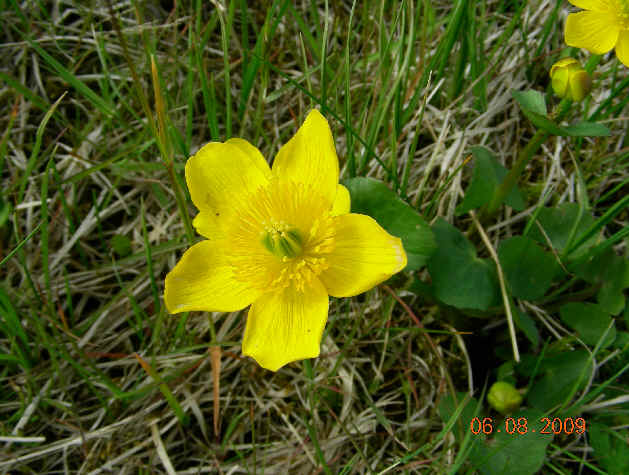
Yellow Marsh-marigold
(photo courtesy of Gerin Hood, during the FONT June 2009 Iceland tour)
- Clematis alpina ochotensia (var.
ochotensis) ______ HK
- Clematis fusca ______
HK
- Coptis trifolia ______
HK
- Tall Larkspur ______
AK (NW:467)
Delphinium glaucum
Tall Larkspur is a poisonous plant.
- Glaucidium palmatum ______
HK
- Pulsatilla nipponica ______
HK
- American Pasque Flower (or Spring
Crocus) ______ AK
(NW:460)
Pulsatilla patens
- Meadow Buttercup ______
HK IC (NW:594)
Ranunculus acris
Another name for
Ranunculus acris is Tall Buttercup.
The species in the Ranunculus
genus (this & the following) are poisonous and should not be
eaten.
- Goldilocks Buttercup ______
IC(rare)
Ranunculus
auricomus
- Mountain Buttercup ______ AK
(NW:464)
Ranunculus eschscholtzii
Another name for Ranunculus eschscholtzii
is Eschscholtz's Buttercup.
- Glacier Buttercup ______
IC
Ranunculus glacialis
- Ranunculus horieanus
______ HK
- Arctic Buttercup ______
IC
Ranunculus hyperboreus
The Arctic Buttercup is a
species characteristic of iron-rich spring-water seeping up through mud in
bogs, in Iceland especially in the Central Highlands.
In such places, in Iceland, it is often accompanied by Water Whorlgrass.
- Snow Buttercup
______ AK(*)
Ranunculus nivalis
In Alaska, the Snow Buttercup
is in the eastern, central, and northern parts of the state.
- Western Buttercup ______
AK
Ranunculus occidentalis
- Pigmy Buttercup ______
IC
Ranunculus pygmaeus
- Creeping Buttercup ______ IC
(NW:594)
Ranunculus repens
In Iceland, the Creeping
Buttercup is a rather common naturalized alien. It is found on
cultivated homefields, fertile pastures in villages, near houses and
abandoned farms, and in gardens.
- Creeping Spearwort (ph)
______ HK IC(*)
Ranunculus
reptans
Creeping Spearwort is found in moist soil.
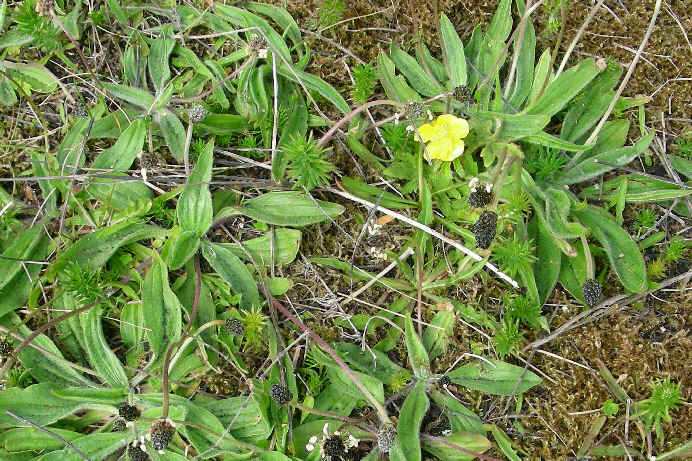
Creeping Spearwort
(photo courtesy of Gerin Hood, during the FONT June 2009 Iceland tour)
- Thread-leaved
Water-crowfoot ______ IC
Ranunculus trichophyllus
- Alpine Meadow-rue
______ IC
Thalictrum alpinum
- Thalictrum
aquilegifolium intermedium ______ HK
- Thalictrum baicalense
______ HK
- Thalictrum integrilobum
______ HK
- Thalictrum mimus
(var. kemense) ______ HK
Thalictrum mimus (var. glabrescensi) ______ HK
Thalictrum mimus (var. apoiense) ______ HK
- Thalictrum sachalinense
______ HK
- Thalictrum tuberiferum
______ HK
- Trautvetteria palmata
(var. palmata) ______ HK
Trautvetteria palmata (var. borealis) ______ HK
- Trollius altaicus
pulcher ______ HK
- Trollius japonicus
______ HK
- Trollius ledebourii
(var. polysepalus) ______
HK
- Trollius riederianus
______ HK
Clubmoss Family,
LYCOPODIACEAE
- Alpine Clubmoss ______
IC
Dipharium alpinum
- Fir Clubmoss ______ IC
Huperzia selago
- Interrupted Clubmoss ______ AK
IC
Lycopodium annotinum
Lycopodium annotinum (var. acrifolium) ______ HK
- Lycopodium chinense
______ HK
- Lycopodium nikoense
______ HK
- Lycopodium selago
______ HK
Lycopodium selago (var. selago) ______ HK
- Lycopodium serratum
______ HK
Crowberry Family,
EMPETRUM
- Crowberry (or
Mooseberry) ______
AK HK IC
Empetrum nigrum
Empetrum nigrum japonicum ______ HK
AN EDIBLE
PLANT: The berries of Crowberry may be used for jelly or pies.
They are easy to pick and keep well.
Cypress Family,
CUPRESSACEAE
- Alaska-cedar ______
AK(southeast)
(ST:73)
Callitropis nootkatensis
Other names for Callitropis
nootkatensis are Nootka Cypress, Stinking Cypress, Yellow
Cypress.
- Juniperus chinensis (var. sargentii)
______ HK
- Common Juniper ______
IC
Juniperus communis
Juniperus communis nana (var. nipponica) ______ HK
Juniperus communis nana (var. saxatilis) ______ HK
Daisy, or Aster Family, ASTERACEAE
- Siberian Yarrow ______
(NW:109)
Achillea alpina
Achillea alpina camtschatica
______ HK
- Northern Yarrow ______ AK
Achillea borealis
- Yarrow ______
IC (NW:109)
Achillea millefolium
Another name for Achillea
millefolium is Milfoil.
- Sneezewort ______ HK
IC
Achillea ptarmica
Achillea ptarmica macrocephalia (var. yezoensis) ______ HK
- Achillea sibirica
______ AK
- Anaphalis lactea
______ HK
- Pearly Everlasting ______
(NW:93)
Anaphalis margaritacea
Anaphalis margaritacea margaritacea ______ HK
Anaphalis margaritacea
yedoensis ______
HK
- Pussy Toes
______ AK
Antennaria sp.
In Alaska, there are numerous
species of Antennaria, separated
by minor characteristics. Some are pink, but the following species (the Cat's
Paw) is a whit alpine species.
- Alpine Cat's Foot ______
IC
Antennaria alpina
- Antennaria dioica
______ HK
- Cat's Paw
______ AK
Antennaria monocephala
- Alpine Arnica
______ AK
Arnica alpina angustifolia
- Arnica amplexicaulis
______ AK
- Arnica chamissonis
______ AK
- Frigid Arnica
______ AK
Arnica frigida
- Meadow Arnica
______ AK
Arnica latifolia
- Lessing's Arnica
______ AK
Arnica lessingii
- Arnica sachalinensis
______ HK
- Arnica unalaschcensis
(var. unalaschcensis) ______
HK
- Artemisia arctica
sachalinensis ______ HK
- Frigid Wormwood (or
Prairie Sagebrush) ______ AK
Artemisia frigida
- Artemisia schmidtiana
______ HK
- Artesmisia tanacetifolia
______ HK
- Common Wormwood
______ AK
Artemisia tilesii
- Artemisia trifurcata
______ HK
- Artemisia unalaskensis
______ HK
- Siberian Aster
______ AK
Aster sibiricus
- Pineappleweed ______ IC
Chamomilla suaveolens
- Arctic Daisy ______
AK
Chrysanthemum arcticum
arcticum
- Cirsium alpicola
______ HK
- Cirsium apoense
______ HK
- Creeping
Thistle ______ IC
Cirsium arvense
- Cirsium grayanum
______ HK
- Cirsium hidakamontanum
______ HK
- Cirsium kamschaticum
______ HK
- Cirsium pectinellum
______ HK
Cirsium pectinellum (var. alpinum) ______ HK
- Crepis gymnopus
______ HK
- Crepis hokkaidoensis
______ HK
- Marsh Hawk's-beard ______ IC(very
rare)
Crepis paludosa
In Iceland, Marsh Hawk's-beard
is found only in the outer districts on both sides of Eyjafjordur.
- Erigeron acer (var. acer)
_____ HK
Erigeron acer (var. kamtschaticus) ______ HK
- Alpine Fleabane
______ IC
Erigeron borealis
In Iceland, Alpine Fleabane is
common throughout. It grows on slopes and grassy moors.
MEDICINAL USE:
the whole plant, with the exception of the root
Used EXTERNALLY, Alpine Fleabane is very useful to treat burns,
inflammation, and melanoma ulcers.
Poultices of the herb are also effective in treating rheumatic inflammation
and sore muscles.
Alpine Fleabane is useful as a gargle for mouth and throat ulcers and
inflammation.
Alpine Fleabane
can be dangerous if used internally, It was used that way in the past, but
it is now evident that protracted use can cause hepatic toxicity, which
could even be fatal.
- Snow Fleabane
______ IC
Erigeron humilis
- Coastal Fleabane ______
AK
Erigeron peregrinus
- Erigeron miyabeanis
______ HK
- Erigeron thunbergii
glabratus (var. glabratus) ______ HK
Erigeron thunbergii glabratus (var. angustifolis) ______ HK
- Dwarf Fleabane
______ IC
Erigeron uniflorus
- Marsh Cudweed ______
IC
Filaginella uliginosa
- Hawkweed ______ IC
Hieracium spp.
The Hawkweeds are a very
difficult group, having been divided, in Iceland, into about 200
microspecies, or varieties.
- Alpine Hawkweed ______
IC
Hieracium alpinum
- Hypochaeris crepidioides
______ HK
- Ixeridium dentatum
nipponicum (var. albiflorum) ______ HK
- Autumn Hawkbit ______
IC
Leontodon autumnalis
- Leontopodium
discolor ______ HK
- Leontopodium japonicum
______ HK
- Leotopodium miyabeanum
______ HK
- Oxeye Daisy
______ IC (NW:570)
Leucanthemum vulgare
- Ligularia hodgsonii
______ HK
- Pineapple Weed ______
AK
Matricaria
matricarioides
Matricaria
matricarioides is a different plant than Chamomilla
suaveolens. Both have the common name Pineapple Weed.
In Alaska, Matricaria matricarioides
is introduced.
- Sea Mayweed (ph) ______ IC(*)
Matricaria maritima
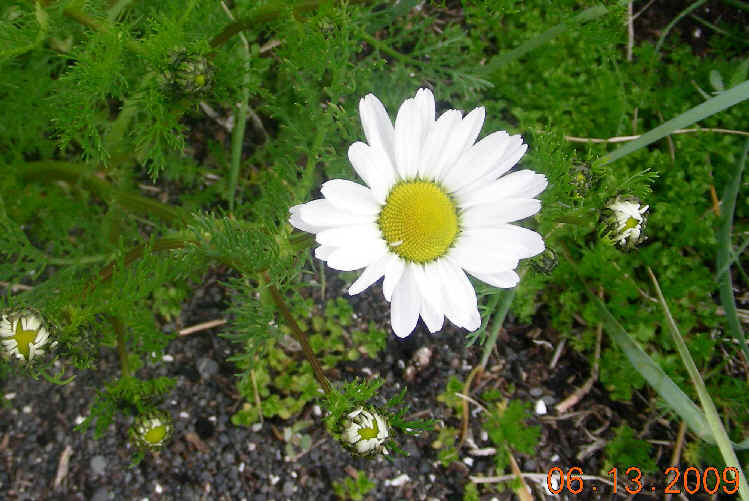
Sea Mayweed
(photo courtesy of Gerin Hood, during the FONT June 2009 Iceland tour)
- Highland Cudweed ______
IC
Omalotheca norvegica
- Dwarf Cudweed ______ IC
Omalotheca supina
- Heath Cudweed ______ IC
Omalotheca sylvatica
- Parasenecio auriculatus
(var. bulbifera) ______ HK
- Frigid Coltsfoot
______ AK (NW:107)
Petasites frigidus
Another name for
Petasites frigidus is Sweet Coltsfoot.
- Northern Coltsfoot
______ AK
Petasites hyperboreus
- Arrowleaf
Coltsfoot ______ AK
Petasites sagitus
- Picris hieracioides
kamtschatica ______ HK
Picris hieracioides kamtschatica (var. jessoensis) ______ HK
Picris hieraciodes japonica ______ HK
- Icelandic Hawkweed ______
IC
Pilosella islandica
- Saussurea chionophylla
______ HK
- Saussurea fauriei
______ HK
- Saussurea kudoana
(var. kudoana) ______ HK
Saussurea kudoana (var. yuparensis) ______ HK
- Saussurea riederi
yesoensis (var. yaeoensis) ______ HK
Saussurea riederi daisetsuensis (var. insularis)
______ HK
- Saussurea yanagisawae
______ HK
- Scorzonera rebunensis
______ HK
- Marsh Fleabane (or
Mastodon Flower) ______ AK
Senecio congestus
- Senecio conterminus
______ AK
- Senecio cymbalarioides
______ AK
- Black-tipped
Groundsel ______ AK
Senecio lugens
- Senecio nemorensis
______ HK
- Senecio pauciflorus
______ AK
- Beach Fleabane
______ AK
Senecio pseudo-arnica
- Triangular-leaved
Fleabane ______ AK
(NW:140)
Senecio triangularis
Another name for Senecio
triangularis is Arrow-leaved Ragwort.
- Groundsel ______
AK IC
Senecio vulgaris
- Canadian Goldenrod ______ AK
(NW:135)
Solidago canadensis
- Solidago horicana
______ HK
- Elegant Goldenrod
______ AK
Solidago lepida
- Northern Goldenrod
______ AK (NW:135)
Solidago multiradiata
Other names for Solidago
multiradiata are Alpine Goldenrod and Rocky
Mountain Goldenrod.
- Solidago virgaurea
asiatica ______ HK
Solidago virgaurea leiocarpa ______ HK
- Dandelion (ph) ______
IC(*) (NW:569)
Taraxacum spp.
Dandelions are very variable plants and are often separated into
different numbers of microspecies. Since they reproduce by agamospermy, the
distinction between many of the microspecies is unclear.
In Iceland, Dandelions are common "everywhere", growing in
grassland, near homes and farms, and in the mountains.
MEDICINAL USE: roots and leaves, gathered
before flowering
The Dandelion is a very important medicinal herb. The roots and
leaves are mixed to gain the most advantageous effects of both.
The leaves, which are very nutritious, are diuretic and high in potassium
(but have little effect on the liver). They are used, therefore, for oedema,
especially if caused by a weak heart.
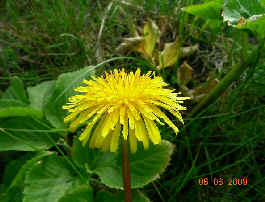
Dandelion
(photo courtesy of Gerin Hood, during the FONT June 2009 Iceland tour)
- Taraxacum ceratophorum
______ HK
- Taraxacum ohirenses
______ HK
- Taraxacum shikotanense
______ HK
- Taraxacum venustum
______ HK
- Taraxacum yuparense
______ HK
Taraxacum yuparense (var. grandisquamatum) ______
HK
- Tephroseris kawakamii ______
HK
- Colt's-foot ______ IC
(NW:572)
Tussilago farfara
Diapensia Family,
DIAPENSIACEAE
- Diapensia (or Lapland
Diapensia) ______ AK
HK IC (NW:212)
Diapensia lapponica
Diapensia lapponica obovata ______ AK HK
- Schizocodon
soldanelloides ______ HK
Schizocodon soldanelloides (var. magnus) ______ HK
Dock, or Buckwheat Family, POLYGONACEAE
- Aconogonon ajanense ______
HK
- Aconogonon nakaii ______
HK
- Aconogonon weyrichii ______
HK
Aconogonon weyrichii (var. alpinum) ______
HK
- Bistorta officinalis (var. pacifica)
______ HK
- Alpine Bistort ______ HK
IC(*) (NW:433)
Bistorta vivipara
Other names for
Bistorta vivipara are: Osterick, Snakeweed, Serpent-grass,
Adderwort, and Viviparous Knotweed.
In Iceland, Alpine Bistort is very common throughout. It grows in
nearly all types of soils, in the highlands as well as in settled areas at
lower elevations.
MEDICINAL USE:
the root
Alpine Bistort is used for various types of pain and hemorrhage in
the digestive tract (for example, for gastritis and colitis).
The root is also useful for gingivitis and soreness of the mouth and throat
as well as for cervical soreness.
A decoction of the root can be used to treat sores that are hard to heal.
- Iceland-purslane ______
IC
Koenigia islandica
- Mountain Sorrel (ph)
______ AK HK IC(*)
(NW:429)
Oxyria digyna
Oxyria digyna occurs commonly in Iceland, at ravines, cliffs,
gravelly slopes, and rocky ground.
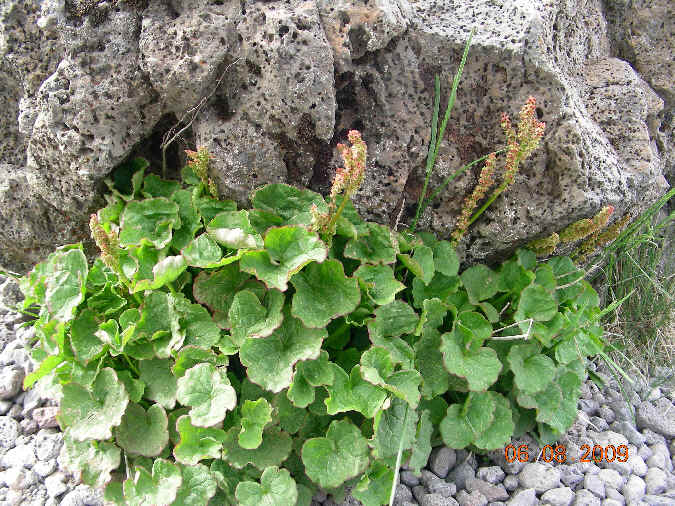
Mountain Sorrel
(photo courtesy of Gerin Hood, during the FONT June 2009 Iceland
tour)
- Amphibious Bistort
______ IC
(NW:431)
Persicaria amphibia
Another name for Persicaria
amphibia is Water Smartweed.
- Wild Rhubarb
______ AK
Polygonum alaskanum
AN EDIBLE
PLANT: Young stems and leaves of the Wild Rhubarb may be eaten
raw or cooked.
- Common Knotgrass ______ IC
Polygonum aviculare
MEDICINAL USE:
the whole plant except the root
Common Knotgrass is used mainly for internal hemorrhaging especially
in the alimentary tract. It is especially effective against diarrhea.
It can also be used for stones in the urinary tract, in which case the herb
must be taken regularly for a long period.
Crushed knotgrass inhaled through the nose is effective in curtailing
nosebleeds.
Poultices and ointments of knotgrass can be used for suppurating
sores.
- Pink Plumes ______ AK
Polygonum bistorta
AN EDIBLE
PLANT: Leaves of the Pink Plumes may be eaten raw or
cooked.
- Alpine Meadow Bistort ______ AK
Polygonum viviparum
AN EDIBLE PLANT: The
boiled roots of the Alpine Meadow Bistort are a good source of starch
, and the leaves of the plant may be eaten raw or cooked.
- Common Sorrel ______
IC
Rumex acetosa
In Iceland, Common Sorrel is very common, It grows in many
types of dry soils, especially in grasslands and hayfields.
MEDICINAL USE: the leaves
Common Sorrel is considered useful to treat oedema, especially if
caused by malfunction of the liver which the herb is thought to stimulate
and strengthen.
It also can be good for poor appetite, scurvy, constipation, and
hemorrhoids.
A fresh juice of the leaves of Common Sorrel, diluted with vinegar,
can be an excellent lotion for skin disorders, such as furuncles, mycosis,
itchy eczema, and neoplasms.
Mountain Sorrel, Oxyria dygina (above),
has characteristics and effects similar to those of Common Sorrel.
Sheep's Sorrel, Rumex acetosella (below), is
often confused with Common Sorrel.
Sheep's Sorrel is a closely related, smaller herb.
- Sheep Sorrel ______
AK IC
Rumex acetosella
- Rumex alpestris
______ HK
- Arctic Dock
______ AK
Rumex arcticus
- Curly Dock ______ IC(rare
alien) (NW:592)
Rumex crispus
- Rumex gmelinii
______ HK
- Northern Dock ______ IC
Rumex longifolius
Dogbane Family, APOCYNACAE
- Vincetoxicum inamoenum
______ HK
Dogwood Family, CORNACEAE
The genus Cornus has
been said to be Chamaepericlymenum.
- Dwarf Dogwood ______ AK
HK (NW:204)
Cornus canadensis
Other names for Cornus canadensis are the
Canadian Dwarf Cornel, and
Bunchberry.
- Red Twig Dogwood ______ AK
Cornus stolonifera
- Dwarf Cornel
______ IC HK
Cornus suecicum
Another name for Cornus suecica is the Swedish Dwarf Cornel.
Earthsmoke, or Fumitory Family, FUMARIACEAE
- Bolden Corydalis ______ AK
(NW:250)
Corydalis aurea
Another name for Corydalis aurea
is Scrambled Eggs.
- Corydalis curvicalcarata
______ HK
- Few-flowered
Corydalis ______ AK
Corydalis pauciflora
- Pale Corydalis (or
the Rock Harlequin) ______
AK (NW:251)
Corydalis sempervirens
In Alaska, Corydalis sempervirens is introduced.
- Dicentra peregrina
______ HK
Eel-grass Family,
ZOSTERACEAE
- Eelgrass ______
IC
Zostera marina
Fern
and
Hardfern Families, BLECHNACEAE and DRYOPTERIDACEAE
- Hard Fern ______ IC
Blechnum spicant
- Holly Fern ______
IC
Polystichum lonchitis
Figwort
Family, SCROPHULARIACEAE
- Arctic Bartsia (ph)
______ IC(*)
Bartsia alpina
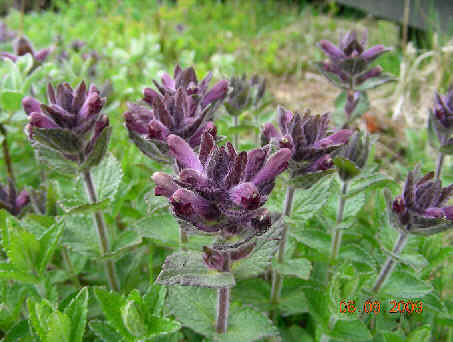
Arctic Bartsia
(photo courtesy of Gerin Hood, during the FONT June 2009 Iceland
tour)
- Elegant Paintbrush ______
AK(*)
Castilleja elegans
In Alaska, the Elegant Paintbrush grows in interior Alaska and on
the North Slope.
- Castilleja hyetophia ______
AK
- Red Indian Paintbrush ______ AK
(NW:538)
Castilleja miniata
Castilleja miniata has a few
other common names including: Giant Red Indian Paintbrush, Great Red
Indian Paintbrush, and Scarlet Red Indian Paintbrush.
- Yellow Paintbrush (or
Coastal Paintbrush) ______ AK
Castilleja unalaschensis
- Arctic Eyebright ______
IC
Euphrasia arctica
- Cold Eyebright ______ IC
Euphrasia frigida
MEDICINAL USE: the entire plant when
in flower, except the root
Cold Eyebright is one of the better herbs for persistent runny nose,
sinus inflammation, and bronchitis.
The plant strengthens mucous membranes and dries excessive secretions.
Thereby it also counteracts gastroenteritis.
- Euphrasia maximowiczii
(var. yesoensis) ______ HK
- Euphrasia pectinata
(var. obtusiserrata) ______ HK
- Mudwort ______ IC
Limosella aquatica
- Yellow Toadflax (or Butter and
Eggs) ______ AK (NW:597)
Linaria vulgaris
In Alaska, Linaria
vulgaris has become naturalized. It is native to Eurasia.
- Small Cow-wheat ______
IC(rare
& localized)
Melampyrum
sylvaticum
- Yellow Monkey-flower (or Wild
Snapdragon) ______ AK (NW::512)
Mimulus guttatus
- Purple-flowered Monkey-flower
______ AK (NW:513)
Mimulus lewisii
Mimulus lewisii
is also called Lewis' Monkey-flower.
- Mimulus sessilifolius
______ HK
- Pedicularis apodochila
______ HK
- Capitate Lousewort
______ AK
Pedicularis capitata
- Pedicularis chamissomis
(var. hokkaidoensis) ______ HK
Pedicularis chamissomis (var. rebunensis) ______ HK
- Upright Lousewort ______ IC
Pedicularis flammea
- Wooly Lousewort
______ AK
Pedicularis kanei kanei
- Pedicularis koidzumiana
______ HK
- Labrador Lousewort
______ AK
Pedicularis labradorica
- Pedicularis lapponica
______ AK
- Pedicularis oederi
______ AK
HK
Pedicularis oederi (var. heteroglossa) ______
HK
- Pedicularis resupinata
oppositifolia ______
HK
- Pedicularis
schistostegia ______
HK
- Pedicularis verticillata
______ HK
- Pedicularis yesoensis
______ HK
- Penstemon frutescens
______ HK
- Yukon Beardtongue ______ AK
Penstemon gormanii
- Yellow-rattle (or
Rattlebox) ______ AK IC
(NW:543)
Rhinanthus minor
In Iceland, Yellow-rattle
is often called Peningagras (translated to "Penny-grass")
by children because of the shape of the fruits, that they use as play
money.
The flowers of the Yellow-rattle, or Rattlebox are small and
inconspicuous, protruding from the calyx.
The rather hairy calyx forms an urn-like structure that rattles when seeds
within the ovary are mature, thus the common names for the plant.
- Blue Water-speedwell ______ IC
(NW:529)
Veronica anagallis-aquatica
- Alpine Speedwell
______ IC
Veronica alpina
- Veronica americana
______ AK
- Germander
Speedwell ______ IC
Veronica chamaedrys
- Rock Speedwell
______ IC
Veronica fruticans
- Heath Speedwell
______ IC
(NW:596)
Veronica officinalis
Veronica
officinalis is also called Common Speedwell.
MEDICINAL USE: the
dried plant in flower
Heath Speedwell, or Common Speedwell, is sudorific, diuretic,
an expectorant, and heals externally.
It is used less for medicinal purposes now than it was in the past, as the
herb has a very mild effect.
It was traditionally used for many ailments, such as scurvy, lack of
appetite, anorexia, kidney stones, rash and irritated skin. It was also
thought to help dry cough.
- Common
Field-Speedwell ______ IC(introduced)
Veronica persica
- Marsh Speedwell
______ IC (NW:529)
Veronica scutellata
Other names for Veronica
scutellata are Narrow-leaved Speedwell and Grass-leaved
Speedwell.
- Thyme-leaved
Speedwell (or Brook Veronica) ______
AK HK IC
Veronica serpyllifolia
Veronica serpyllifolia humifusa ______
HK
- Veronica stelleri
______ AK
HK
Veronica stelleri (var. longistyla) ______ HK
- American Alpine-Speedwell
______ AK (NW:530)
Veronica wormskjoldii
Another name for Veronica
wormskjoldii is Alpine Veronica.
Flax Family, LINACEAE
- Fairy Flax ______
IC
Limun catharticum
- Wild Blue Flax
______ AK
Limun perenne
Gentian
Family, GENTIANACEAE
- Whitish Gentian ______
HK (NW:253)
Gentiana algida
Another name for Gentiana algida
is Arctic Gentian.
- Glaucous Gentian ______ AK
HK
Gentiana glauca
- Gentiana jamesii
______ HK
- Gentiana nipponica
______ HK
- Alpine Gentian
______ IC
Gentiana nivalis
- Gentiana thunbergii
______ HK
- Gentiana triflora
(var. japonica) ______
HK
- Northern Gentian
______ HK IC (NW:255)
Gentianella amarella
Gentianella amarella takedae ______ HK
Other names for Gentianella
amarella included Autumn Gentian, Autumn Dwarf-Gentian,
and Felwort.
- Northern Gentian
______ IC
Gentianella aurea
- Gentianella auriculata
______ HK
- Field Gentian
______ IC
Gentianella campestris
- Serrate Gentian
______ IC
Gentianella detonsa
- Slender Gentian
______ IC
Gentianella tenella
- Arctic Felwort
______ IC
(NW:257)
Lomatogonium rotatum
Another name for
Lomatogonium rotatum is Marsh Felwort.
- Star Gentian
______ AK HK
(NW:257)
Swertia perennis
Swertia perennis cuspidata ______ HK
Swertia
perennis is also called Felwort.
- Swertia tetrapetala
tetrapetala ______ HK
Swertia tetrapetala tetrapetala (var. yezoalpina) ______ HK
- Tripterospermum
trinervium (var. involubile) ______
HK
Geranium Family, GERANIACEAE
- Cranesbill (or Wild
Geranium) ______ AK HK
Geranium erianthum
- Geranium onoei
(var. onoei) ______ HK
- Wood Crane's-bill (ph)
______ IC(*)
Geranium sylvaticum
The name "crane's-bill" is from the shape of the
seed pods once the petals have faded. The seed heads snap open like bird
beaks to release the seeds.
Other common names for plants in GERANIACEAE, more to the south, are "stork's-bill"
and "heron's-bill".
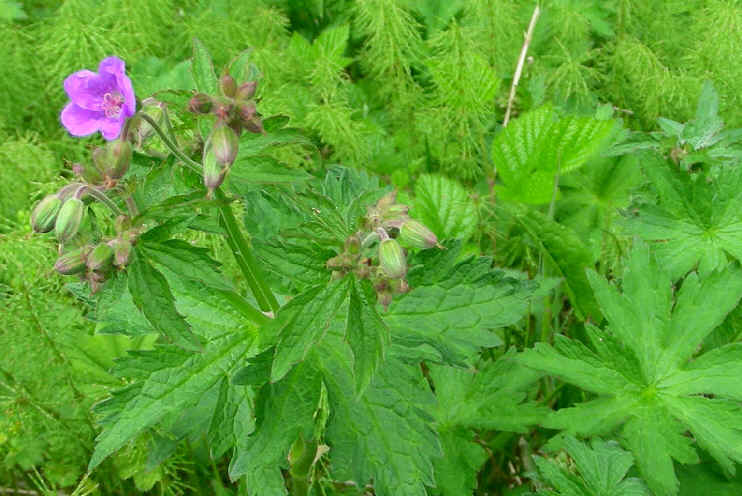
Wood Crane's-bill
(photo courtesy of Gerin Hood, during the FONT June 2009 Iceland
tour)
- Geranium yesoense
(var. yesoense) ______ HK
Geranium yesoense (var. pseudopalustre) ______ HK
Ginseng Family,
ARALIACEAE
- Devil's Club ______
AK
Echinopanax horridum
Gooseberry Family, GROSSULARIACEAE
- Ribes horridum ______
HK
- Northern Black Currant ______ AK
Ribes hudsonium
- Northern Red Currant ______ AK
Ribes iriste
- Ribes japonicum
______ HK
- Bristly Black Currant (or
Gooseberry) ______ AK
Ribes lacustre
- Ribes latifolium
______ HK
- Trailing Black Currant ______ AK
Ribes laxiflorum
- Ribes sachalinense
______ HK
- Ribes triste
______ HK
Goosefoot
Family, CHENOPODIACEAE
- Babington's Orache ______ IC
Atriplex glabriuscula
- Long-stalked Orache ______ IC
Atriplex longipes
- Fat-hen ______
IC(an alien)
Chenopodium album
- Strawberry Spinach (or Strawberry
Blite) ______ AK
(NW:197)
Chenopodium capitatum
Chenopodium capitatum
is also called Indian Paint.
AN EDIBLE
PLANT: The sweet fruit of Strawberry Spinach may be eaten raw or
used for jelly and syrup. Its tasty leaves are very similar to those of its
close relative, Spinach.
Grass Family, POACEAE
- Common Bent-grass ______ IC
Agrostis capillaris
Species in the genus Agrostis are generally referred to as
bent-grasses.
- Agrostis flaccida _____
HK
- Creeping Bent-grass ______
IC
Agrostis stolonifera
- Velvet Bent-grass ______ IC
Agrostis vinealis
- Orange Foxtail ______ IC
Alopecurus aequalis
- Marsh Foxtail ______
IC
Alopecurus geniculatus
- Meadow Foxtail ______ IC
Alopecurus pratensus
- Anthoxanthum nipponicum ______
HK
Species in the genus Anthoxanthum are generally referred to vernal grasses.
- Sweet Vernal Gras ______ IC
Anthoxanthum odoratum
- Hungarian Brome ______ IC
Bromus inermis
- Calamagrostis hakonensis ______
HK
Species in the genus Calamagrostis are generally referred to as
reed-grasses.
- Calamagrostis neglecta inexpansa
______ HK
- Calamagrostis purpurea langsdorfii
______ HK
- Calamagrostis sachalinensis
______ HK
- Calamagrostis sesquiflora
______ HK
- Narrow Small Reed-grass ______ IC
Calamagrostis stricta
- Whorl-grass ______
IC
Catabrosa aquatica
- Cock's-foot ______ IC
Dactylis glomerata
- Alpine Hair-grass ______ IC
Deschampsia alpina
Species in the genus Deschampsia are generally referred to as
hair-grasses.
- Deschampsia atropurpurea (var.
paramushirensis) ______ HK
- Tufted Hair-grass ______ AK HK IC
Deschampsia cespitosa
Deschampsia cespitosa (var. festucifolia) ______
HK
Deschampsia cespitosa (var. levis) ______ HK
- Slender Hair-grass ______
AK
Deschampsia elongata
- Wavy Hair-grass ______ HK
IC
Deschampsia flexuosa
- Northern Couch ______ AK
IC
Elymus alaskanus
Other names for Elymus alaskanus
are Alaskan Wheatgrass and Alaska Wild Rye.
- Lyme Grass (or Beach Rye
Grass) ______ AK IC
Elymus
(or Leymus) arenarius
- Bearded Couch ______ IC
Elymus caninus
- Common Couch ______
IC
Elymus repens
Common Couch occurs throughout Iceland. There, and elsewhere, it
is around farms and in neglected gardens.
it is regarded as among the worst of weeds.
MEDICINAL USE: the rhizomes and stolons
Common Couch is used extensively to treat urinary ailments, such as
cystitis, prostatitis, nephritis, and discomfort from kidney stones and
gravel.
The plant can have a prompt effect relieving pain and cramps. It is
completely harmless, even for children.
- Elymus yubaridakensis
______ HK
- Festuca
ovina ruprechtii ______ HK
- Meadow Fescue ______
IC
Festuca pratensis
- Arctic Fescue ______
IC
Festuca richardsonii
- Red Fescue ______
IC
Festuca rubra
The Red Fescue is closely related to Arctic Fescue and the two have been
regarded as the same species.
In Iceland, Red Fescue is introduced, and now widespread.
- Viviparous Fescue ______
IC
Festuca vivipara
- Glyceria alnasteretum
______ HK
Species in the genus Glyceria are generally referred to as manna-grasses, or
sweet-grasses.
- Floating Sweet-grass ______ IC
Glyceria fluitans
- Hierochloe alpina ______
HK
Species in the genus Hierochloe are generally referred to as
sweet-grasses.
- Holy-grass ______ IC
Hierochloe odorata
- Hierochloe pluriflora ______
HK
Hierochloe pluriflora (var. intermedia) ______ HK
- Yorkshire-fog ______
IC
Holcus lanatus
- Squirreltail
Grass ______ AK
Hordeum jubatum
- Wood Millet
______ IC
Milium effusum
- Mat Grass ______ IC
Nardus stricta
- Snow Goosegrass
______ IC
Phippsia algida
- Alpine Cat's-tail ______ HK
IC
Phleum alpinum
- Timothy ______
IC
Phleum pratense
- Alpine
Meadow-grass ______ IC
Poa alpina
Species in the genus Poa are generally called
meadow-grasses.
- Annual
Meadow-grass ______ IC
Poa annua
- Wavy Meadow-grass
______ IC
Poa flexuosa
- Glaucous
Meadow-grass ______ IC
Poa glauca
- Poa hayachinensis
______ HK
- Wood Meadow-grass
______ IC
Poa nemoralis
- Smooth
Meadow-grass ______ IC
Poa pratensis
- Rough Meadow-grass
______ IC
Poa trivialis
- Reflexed Saltmarsh-grass
______ IC
Puccinellia distans
- Common Saltmarsh-grass
______ IC
Puccinellia maritima
- Blue Moor-grass
______ IC
Sesleria albicans
- Spiked Oat-grass
______ AK HK IC
Trisetum spicatum
Another name for Trisetum spicatum is
Spiked Trisetum.
Heath Family, ERICACEAE
- Bog Rosemary ______
AK HK IC(very
rare) (NW:215)
Andromeda polifolia
In Iceland, the Bog Rosemary has recently been discovered in the
northern part of the eastern fjords.
Bog Rosemary is very poisonous plant. It can
cause rapid lowering of blood pressure if eaten..
- Arctererica nana ______
HK
- Alpine Bearberry ______ AK
(NW:216)
Arctostaphylos alpina
- Bearberry (ph) ______
AK
IC(*) (NW:216)
Arctostaphylos uva-ursi
Another name for Arctostaphylos uva-ursi
is Kinnikinnick.
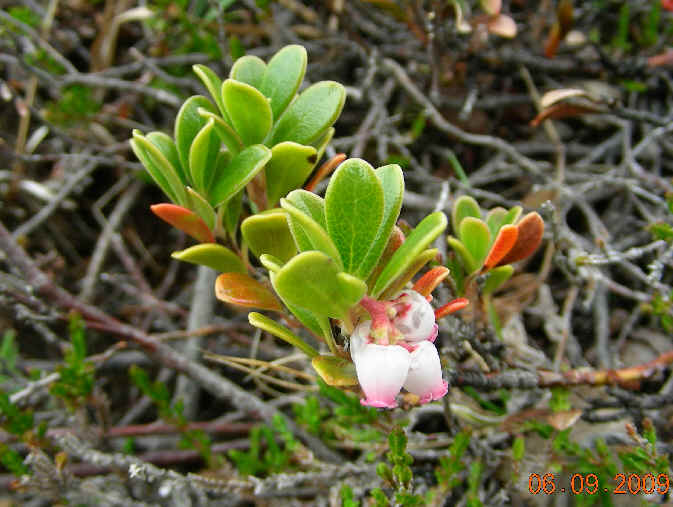
Bearberry
(photo courtesy of Gerin Hood, during the FONT June 2009 Iceland
tour)
- Arctous alpina (var. japonica)
______ HK
- Bryanthus gmelininii ______
HK
- Heather
______ IC
Calluna vulgaris
- Cassiope
______ IC
Cassiope hypnoides
- Cassiope lycopodioides
______ HK
- Moss Heather ______
AK
Cassiope stelleriana
- Cladothamnus bracteatus
______ HK
- Elloittia paniculata
______ HK
- Epigaea asiatica
______ HK
- Gaultheria adenothris
______ HK
- Gaultheria miqueliana
______ HK
- Harrimanella stelleriana
______ HK
- Leucothoe grayana
(var. hypoleuca) ______ HK
- Trailing Azalea (or Alpine
Azalea) ______ AK HK IC
Loiseleuria procumbens
- Rusty Menziesia
______ AK
Menziesia ferruginea
Other names for Menziesia ferruginea are
Fool's Huckleberry and False
Azalea.
- Menziesia multiflora ______
HK
- Menziesia pentandra ______
HK
- Monotropastrum humile
______ HK
- Phyllodoce aleutica ______
HK
- Mountain Heath ______
HK IC (NW:220)
Phyllodoce caerulea
Phyllodoce caerulea (var. yesoensis) ______ HK
Phyllodoce caerulea (var. marmorata) ______
HK
Another somewhat inappropriate name for Phyllodoce caerulea has been
Blue
Heath.
- Phyllodoce nipponica
tsugifolia ______ HK
- Rhododendron albrechtii
______ HK
- Rhododendron aureum
______ HK
- Rhododendron
brachycarpum ______ HK
- Rhododendron dauricum
______ HK
- Rhododendron dilatatum
(var. boreale) ______ HK
- Rhododendron kaempferi
(var. kaempferi) ______ HK
- Lapland Rosebay ______ AK
(NW:219)
Rhododendron lapponicum
- Bog Labrador Tea (ph)
______ AK(*) HK
(NW:219)
Rhododendron groenlandicum (was Ledum latifolium, and Ledum
groenlandicum)
Rhododendron groenlandicum diversipilosum ______
HK
Another species, the Northern Labrador Tea, Rhododendron tomentosum, was
Ledum palustre.
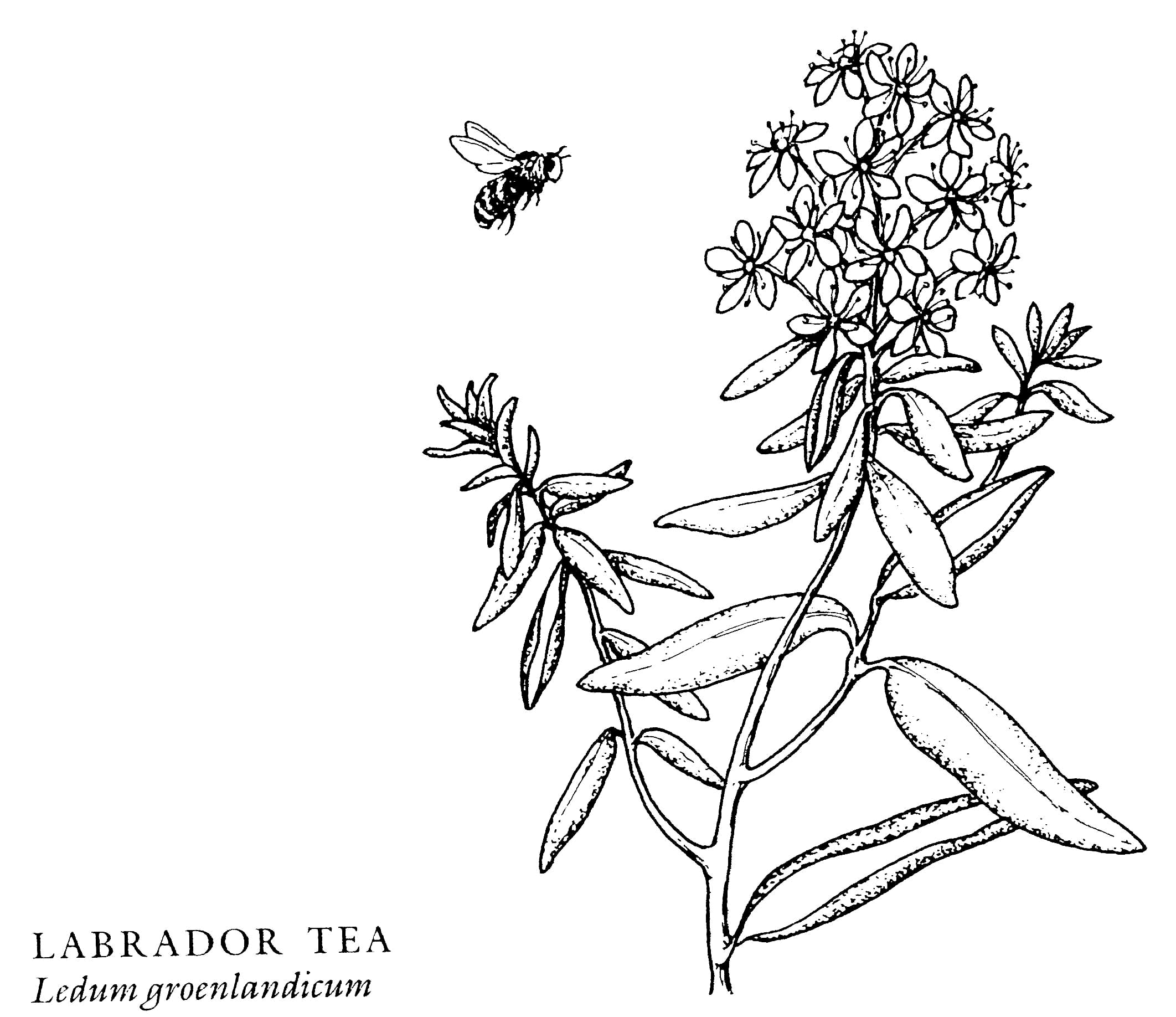
When this drawing was made, the plant was called
Labrador Tea, Ledum groenlandicum.
- Rhododendron tschonoskii
______ HK
- Therorhodion
camtschaticum ______ HK
- Vaccinium hirtum
(var. pubescensi) ______
HK
- Common Cranberry
______ IC (NW:220)
Vaccinium macrocarpum
Another name for Vaccinium
macrocarpum is Large Cranberry.
- Bilberry (ph) ______
IC(*)
Vaccinium myrtillus
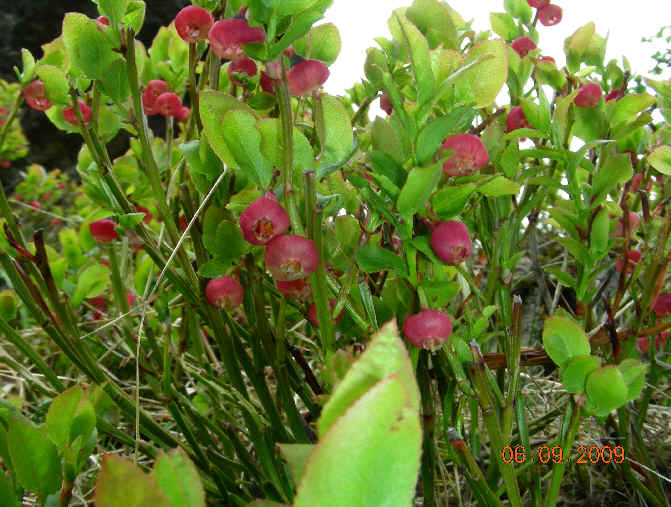
Bilberry
(photo courtesy of Gerin Hood, during the FONT June 2009 Iceland
tour)
- Vaccinium ovalifolium ______
HK
Vaccinium ovalifolium (var. alpinum) ______
HK
- Small Cranberry ______ HK
(NW:220)
Vaccinium oxycoccus
- Vaccinium praestans ______
HK
- Vaccinium smallii ______
HK
- Bog Bilberry (ph) ______
AK HK
IC(*)
Vaccinium uliginosum
Vaccinium uliginosum (var. alpinum) ______ HK
Vaccinium uliginosum (var. japonicum) ______ HK
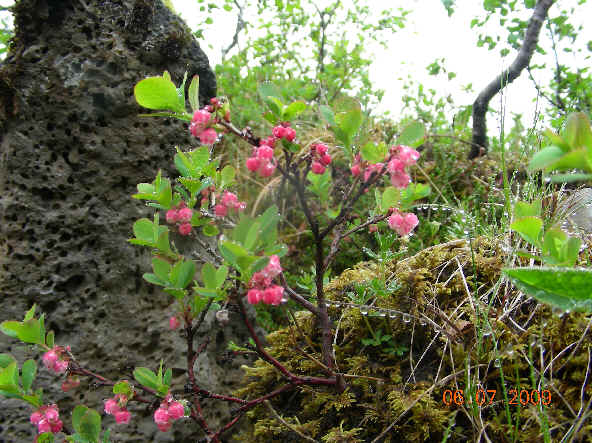
Bog Bilberry
(photo courtesy of Gerin Hood, during the FONT June 2009 Iceland tour)
- Cowberry ______
AK HK IC(very
rare) (NW:220)
Vaccinium
vitis-idaea
Other names for Vaccinium
vitis-idaea are: Low-bush Cranberry, Mountain Cranberry,
and Lingonberry.
Holly Family,
AQUIFOLIACEAE
- Ilex crenata (var.
radicans) ______ HK
- Ilex rugosa
______ HK
- Ilex sugerrokii
(var. brevipadunculata) ______ HK
Honeysuckle Family,
CAPRIFOLIACEAE
- Twin Flower ______ AK
HK (NW:191)
Linnea borealis
Linnea borealis
is one of he few plants or animals named after Linnaeus, who knew it
well from his exploration in northern Sweden. The name was given to the
plant by Linnaeus' teacher in 1753.
- Lonicera alpigena
glehnii ______ HK
- Lonicera chrysantha
(var. crassipes) ______ HK
- Lonicera caerubea edulis
______ HK
Lonicera caerubea edulis (var. venulosa) ______
HK
- Lonicera chamissoi
______ HK
- Macrodiervilla
middendorffiana ______ HK
- Red-berried Elder
______ AK
Sambucus racemosa
All parts of the Red-berried
Elder, except for the pulp of the berries and the flowers, are
poisonous.
- High-bush Cranberry ______ AK
Viburnum edule
- Viburnum furcatum
______ HK
- Viburnum koreanum
______ HK
Horsetail Family,
EQUISETACEAE
- Field Horsetail ______
AK IC
Equisetum arvense
- Water Horsetail ______ IC
Equisetum fluviatile
- Rough Horsetail ______ IC
Equisetum hyemale
- Marsh Horsetail ______
IC
Equisetum palustre
- Shady Horsetail (ph)
______ IC
Equisetum pratense
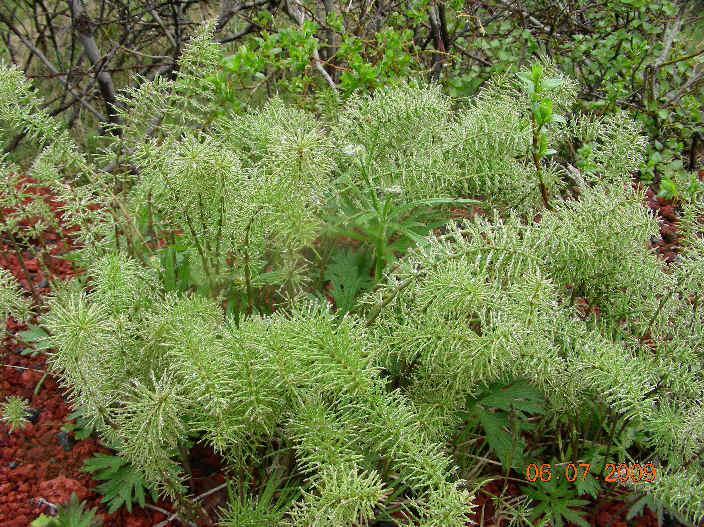
Shady Horsetail
(photo courtesy of Gerin Hood, during the FONT June 2009 Iceland
tour)
- Wood Horsetail ______
IC
Equisetum sylvaticum
- Variegated Horsetail ______ IC
Equisetum variegatum
Hydrangea Family,
HYDRANGEACEAE
- Hydrangea serrata
(var. yesoensis) ______
HK
Iris Family, IRIDACEAE
- Iris laevigata ______
HK
- Iris sanguinea ______
HK
- Wild Iris (or Blue Flag)
______ AK HK
Iris setosa
Ivy, or Aralia Family, ARALIACEAE
- Oplopanax japonicus
______ HK
Lady-fern Family,
ATHYRIACEAE
including Shield-ferns
- Alpine Lady-fern ______
HK IC
Athyrium ditentifolium
- Lady-fern ______ AK
IC
Athyrium filix-femina
- Athyrium rupestre
______ HK
- Brittle Bladder-fern (or Fragile
Fern) ______
AK IC
Cystopteris fragilis
In Iceland, the Brittle
Bladder-fern is by far the most common fern, and the only one that is
widespread throughout the country.
- Dickie's Bladder-fern ______ IC
Cystopteris dickieana
- Northern Buckler-fern ______
IC
Dryopteris assimilis
- Wood-fern ______
AK
Dryopteris dilatata
- Male-fern ______ IC
Dryopteris filix-mas
- Fragrant Shield Fern ______ AK
Dryopteris fragans
- Oak Fern ______
IC
Gymnocarpium dryopteris
- Wilson's Filmy-fern ______ IC
Hymenophyllum wilsonii
- Ostrich Fern
______ AK
Matteuccia struthiopteris
- Alpine Woodsia ______
IC
Woodsia alpina
- Woodsia glabella
______ HK
- Oblong Woodsia ______
HK IC
Woodsia ilvensis
Legume, or Pea Family, LEGUMINOSAE or FABACEAE
- Kidney Vetch ______ IC
Anthyllis vulneraria
In Iceland, Kidney Vetch is rather common on the Reykjanes Peninsula,
but rather rare elsewhere in the country.
- Astragalus adsurgens ______
HK
- Alpine Milk Vetch ______ AK
Astragalus alpinus
- Astragalus frigidus
parviflorus ______ HK
- Astragalus japonicus
______ HK
- Astragalus membranaceus
(var. obtusus) ______ HK
- Astragalus tokachiensis
______ HK
- Hairy Arctic Milk Vetch ______
AK
Astragalus umbellatus
- Eskimo Potato ______ IC
Hedysarum alpinum
- Hedysarum hedysaroides
______ HK
- Wild Sweet Pea ______ IC
Hedysarum mackenzii
The root of the Wild Sweet Pea is said to
be poisonous.
- Hedysarum vicioides (var. japonicum)
______ HK
- Sea Pea ______
IC(*)
Lathyrus japonicus maritimus
- Beach Pea
______ AK
Lathyrus maritimus maritimus
AN EDIBLE
PLANT: the large pods of the Beach Pea are eaten, both raw and
cooked
But caution
should be had with the plants of the Pea Family as they readily
absorb selenium from the soil causing toxicity.
- Marsh Pea ______ IC(very
rare) (NW:245)
Lathyrus palustris
Another name for Lathyrus palustris
is Marsh Vetchling.
- Meadow Vetchling
______ IC
Lathyrus pratensis
- Lespedeza bicolor
(var. nana) ______ HK
- Arctic Lupine
______ AK
Lupinus arcticus
- Nootka Lupine (ph)
______ AK IC(*)
Lupinus nootkatensis
Another name for Lupinus nootkatensis
is Alaska Lupine. It is introduced in Iceland.
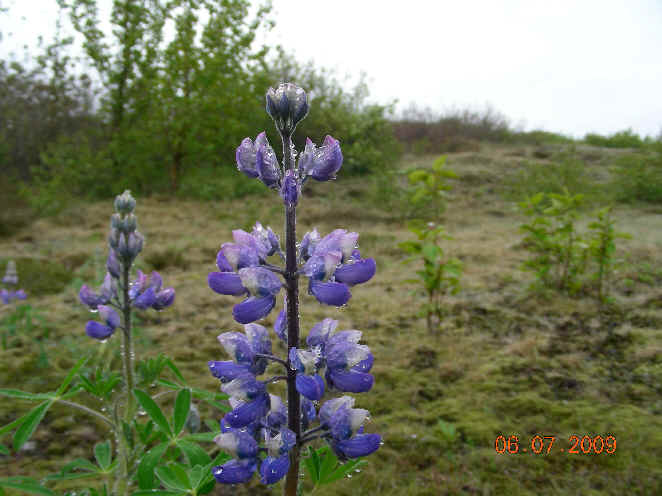
Above & below: Nootka Lupine, photographed during FONT tours in Iceland
(upper photo by Gerin Hood, from our June 2009
tour,
lower photo by Marie Gardner during our tour in June 2015)
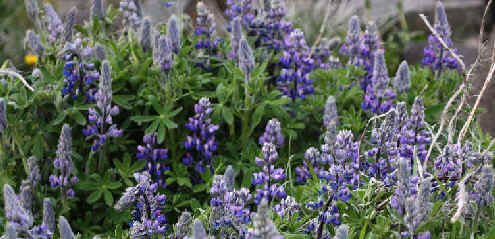
- Yellow Oxytrope ______ AK
HK
Oxytropis campestris
Oxytropis campestris (var. rushiriensis) ______
HK
Many of the Oxytropes contain a toxin and
are commonly called Loco-weed, as grazing cattle are strangely
affected by it causing an uneven gait.
Oxytropes should not be eaten.
- Oxytropis japonica (var. sericea)
______ HK
- Oxytropis maydelliana ______
AK
- Oxytropis megalantha ______
HK
- Blackish (or Purple) Oxytrope
______ AK
Oxytropis nigrescens
- Oxytropis retusa
______ HK
- Oxytropis revoluta
______ HK
- Oxytropis shokanbetsuensis
______ HK
- Oxytropis viscida
______ AK
- Alsike Clover ______
IC
Trifolium hybridum
- White Clover ______
IC (NW:583)
Trifolium repens
- Red Clover (ph) ______
IC(*) (NW:583)
Trifolium pratense
In Iceland, Trifolium pratense
is introduced and partly naturalized. It occurs in grassy pastures and
cultivated homefields. It is rather rare in Iceland.

Red Clover
(photo by Doris Potter)
- Tufted Vetch ______ IC
Vicia cracca
- Bush Vetch
______ IC
Vicia sepium
Lily Family, LILIACEAE
including MELANTHIACEAE (the
genera ANTICLEA and HELONIOPSIS)
and PETROSAVIACEAE (the genus JAPONOLIRION)
- Aletris foliata ______
HK
- Aletris luteoviridis ______
HK
- Allium maximowiczii ______
HK
Allium maximowiczii (var. yezomonticola) ______ HK
- Allium schoenoprasum (var. orientale)
______ HK
- Allium splendens ______
HK
- Anticlea sibirica ______
HK
- Clintonia udensis ______
HK
- Chocolate Lily ______ AK
HK (NW:314)
Fritillaria camschatcensis
Fritillaria camschatcensis (var. keisukei) ______ HK
Other names for Fritillaria camschatcensis are
Kamchatka Fritillary and Rice
Lily.
- Heloniopsis orientalis
______ HK
- Hemerocallis dumortierii
(var. esculenta) ______
HK
- Hosta sieboldii ______
HK
Hosta sieboldii (var. restifolia) ______ HK
- Japonolirion osense ______
HK
Japonolirion osense (var. saitoi) ______
HK
- Lilium medeoloides ______
HK
- Lilium pensylvanicum ______
HK
- Alp Lily
______ AK HK
(NW:315)
Lloydia serotina
- False Solomon's
Seal ______ AK
Smilacina stellata
Smilacina
stellata is poisonous.
- Watermelon Berry ______ AK
(NW:304)
Streptopus
amplexifolius
Streptopus amplexifolius (var. papillatus) ______ HK
Other names for Streptopus
amplexifolius are Twisted Stalk, Clasping-leaf Twisted
Stalk, and Wild Cucumber.
AN EDIBLE PLANT: The sweet juicy berries of
the Watermelon Berry are used for jellies and syrups.
The new shoots, younger leaves and flower buds are tasty additions to
salads.
- Small Twisted-stalk ______
(NW:304)
Streptopus streptopoides japonicus
______ HK
Streptopus streptopoides streptopoides ______
HK
- Trillium apetalon ______
HK
Trillium apetalon (var. rubrocarpum) ______
HK
- Trillium camschatcense ______
HK
Trillium camschatcense (var. kurilense) ______
HK
- Trillium hagae ______
HK
- Trillium smallii ______
HK
- Trillium tschonoskii ______
HK
Trillium tschonoskii (var. atrorubens) ______ HK
- Trillium x miyabeanum ______
HK
- Trillium x yezoense ______
HK
- Veratrum album ______
HK
- Veratrum maackii ______
HK
Veratrum maackii (var. japonicum) ______
HK
Veratrum maackii (var. parviflorum) ______ HK
- Veratrum stamineum ______
HK
Veratrum stamineum (var. lasiophyllum) ______ HK
- Green False Hellebore ______ AK
(NW:301)
Veratrum viride
Another name for Veratrum viride is
Indian-poke.
Veratrum viride is very poisonous. If
eaten, it can cause vomiting, paralysis, death.
- Death Camas (or Camas Wand
Lily) ______ AK
Zygadenus elegans
Zygadenus
elegans has a highly toxic poison that causes vomiting, a lowered body
temperature, and breathing difficulties.
Madder, or Bedstraw Family, RUBIACEAE
- Northern Bedstraw ______ AK IC
(NW:492)
Galium boreale
Northern Bedstraw was used
in early times as mattress stuffing because it is sweet scented and its
square stems do not crush easily.
- Galium kamtschaticum (var.
kamtschaticum) ______ HK
- Galium nakaii ______
HK
- Slender Bedstraw ______ IC
Galium normanii
- Marsh Bedstraw ______
IC(very
rare)
Galium palustre
In Iceland, Marsh Bedstraw
is found at only a few localities in the southwest.
- Small Bedstraw ______
IC
Galium trifidum
- Sweet-scented
Bedstraw ______ AK (NW:491)
Galium triflorum
Another name for
Galium triflorum is Fragrant Bedstraw.
- Fen Bedstraw ______
IC
Galium uliginosum
- Yellow Bedstraw
______ HK IC
(NW:595)
Galium verum
Galium verum asiaticum (var. trachycarpum) ______ HK
Another name for Galium
verum is Lady's Bedstraw.
- Mitchella undulata
______
HK
Mare's-tail Family, PLANTAGINACEAE
- Four-leaved Mare's-tail ______
IC
Hippuris tetraphylla
- Mare's-tail ______
IC
Hippuris vulgaris
MEDICINAL USE: the
whole plant except for the root
Mare's-tail stops or inhibits internal or external hemorrhaging. It
strengthens the lungs and liver, and it is thought to help with kidney
stones.
Mint Family, LAMIACEAE
- Pyramidial Bugle
______ IC
Ajuga pyramidalis
- Hemp-nettle
______ IC
Galeopsis tetrahit
- White Dead-nettle ______
IC
Lamium album
- Red (or Purple)
Dead-nettle
______ IC
(NW:586)
Lamium purpureum
- Nepeta subsessilis
______ HK
Nepeta subsessilis (var. yesoensis) ______ HK
- Selfheal
______ HK IC (NW:279)
Prunella vulgaris
Prunella vulgaris (var. aleutica) ______ HK
Prunella vulgaris asiatica ______ HK
Prunella
vulgaris is also called Heal-all.
- Scutellaria pekinensis
(var. ussuriensis) ______ HK
- Wild Thyme
______ IC
Thymus praecox arcticus
Thymus
praecox is also called Creeping Thyme, with that name
applied where the closely-related Thymus
serpyllum does not occur.
In Iceland, Wild Thyme is common throughout, growing on gravel flats
and on dry moors and slopes.
MEDICINAL USE:
the entire plant in flower, except the root
Wild Thyme is most commonly used for flu and colds, and especially for
bronchitis and other lung ailments. It works as an antiseptic and
expectorant.
It can also be effective against various digestive ailments, such as gastric
and intestinal inflammation. It is thought to work against helicobacter
infections which cause gastritis and stomach ulcers.
Wild Thyme is used, often with other herbs, to relive
cramps.
- Thymus quinquecostatus
______ HK
Thymus quinquecostatus (var. canescens) ______ HK
Mountain Parsley,
Parsley Fern, or Rockbrake Family
subfamily CRYPTOGRAMMOIDEAE in family PTERIDACEAE
- Parsley Fern
______ HK IC(very
rare)
Cryptogramma crispa
Mustard
Family, BRASSICADEAE, formerly
CRUCIFERAE
- Arabidopsis kamchatica kamchatica
______ HK
- Arabidopsis umezawana ______
HK
- Alpine Rock-cress ______ IC
Arabis alpina
- Holboell's Rockcress
______ AK
Arabis holboelli
- Kamchatka Rockcress
______ AK
Arabis lyrata
- Arabis serrata
(var. glauca) ______ HK
- American Wintercress ______ HK
(NW:173)
Barbarea orthoceras
- Winter-cress
______ IC
Barbarea vulgaris
- Bird's Rape
______ AK
Brassica rapa
In Alaska,
Brassica rapa is introduced.
- Sea Rocket ______
IC
Cakile arctica
- Shepherd's Purse ______ AK IC
Capsella bursa-pastoris
In Alaska, the Shepherd's Purse is an introduced species.
- Alpine Bitter-cress ______
IC
Cardamine bellidifolia
- Cardamine fauriei
______ HK
- Hairy Bitter-cress ______ IC
(NW:176)
Cardamine hirsuta
- Cardamine nipponica
______ HK
- Lady Smock (ph) ______
IC(*)
Cardamine nymanii

Lady Smock
(photo courtesy of Gerin Hood, during the FONT June 2009 Iceland Tour)
- Purple Cress ______ AK
Cardamine purpurea
- Cardamine schinziana
______ HK
- Cardamine trifida
______ HK
- Cardamine yesoensis
______ HK
- Northern Rock-cress (ph)
______ IC(*)
Cardaminopsis petraea
Northern Rock-cress is one of the most common wildflowers in Iceland in both the lowlands
and highlands. It occurs in areas of gravel hills, screes, sand and lava
fields.
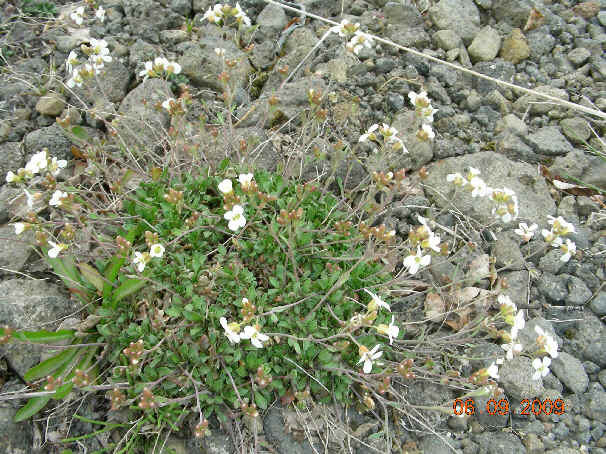
Northern Rock-cress
(photo courtesy of Gerin Hood, during the FONT June 2009 Iceland
tour)
- Common Scurygrass (ph)
______ IC(*)
Cochlearia officinalis
In Iceland, Common Scurvygrass is found widely on
cliffs and rocks on tidal beaches and bird cliffs. It is also in inland
areas.
MEDICINAL USE: the leaves and
roots, containing vitamin C and other vitamins, tannins, glycosides and
strong oil containing among other things, sulphur
Long before vitamins became known, common people in Iceland cured scurvy and
various other ailments with scurvygrass.
Today, in Iceland, it is used mainly for rheumatism, oedema, and various
skin conditions, due to its purging effect on the blood.
A strengthening and cleansing tincture of the herb can be prepared for use
in the winter.
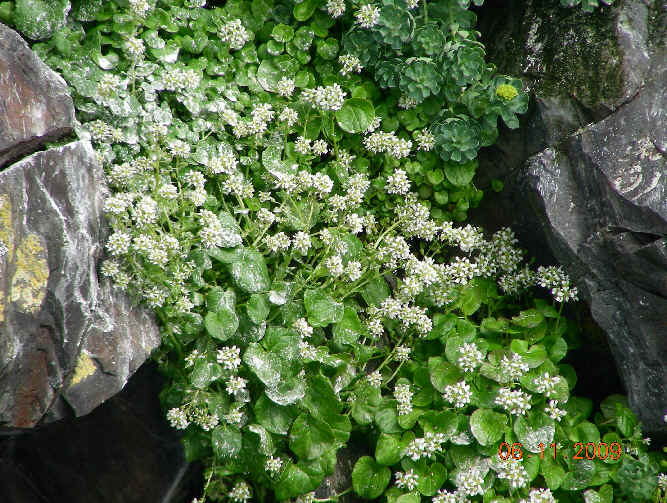
Common Scurvygrass
(photo courtesy of Gerin Hood, during the FONT June 2009 Iceland
tour)
- Flixweed ______ IC(rare)
Descurainia sophia
In Iceland, Flixweed is a very rare alien.
- Alpine Whitlowgrass ______
IC
Draba alpina
- Golden Draba ______ AK
(NW:171)
Draba aurea
- Draba borealis
______ AK
- Draba hirta
______ AK
- Hoary Whitlowgrass ______
IC
Draba incana
- Whitlowgrass
______ AK
Draba incerta
- Draba igarashii
______ HK
- Draba japonica
______ HK
- Draba kitadakensis
______ HK
- Draba maxima
______ AK
- Snow Whitlowgrass (ph)
______ IC(*)
Draba nivalis
Snow Whitlowgrass is rather rare in Iceland, found at rock outcrops
and cairns in the northern and eastern parts of the island.
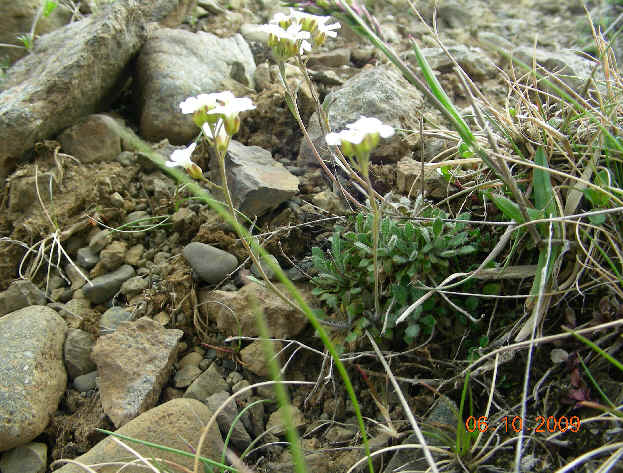
Snow Whitlowgrass
(photo courtesy of Gerin Hood, during FONT June 2009 Iceland
Tour)
- Rock Whitlowgrass ______
IC
Draba norvegica
- Draba sachalinensis
______ HK
- Draba ussuriensis
______ HK
- Common Whitlowgrass ______ IC
(NW:574)
Erophila (or
Draba) verna
- Hawkweed-leaved
Treaclemustard ______ IC
Erysimum hieraciifolium
- Common Mustard (or
Ball Mustard) ______ AK
Leslia paniculata
- Macropodium pterospermum
______ HK
- Parry's Wallflower
______ AK
Parrya nudicaulis interior
- Northern Yellowcress
______ IC
Rorippa islandica
- Awlwort ______ IC
Subularia aquatica
- Field Penny-cress ______ IC
Thlaspi arvense
In Iceland, Field Penny-cress
is a rare alien.
- Thlaspi japonicum
______ HK
Nettle Family,
URTICACEAE
- Common Nettle ______
IC (NW:552)
Urtica dioeca
Another name for Urtica dioeca
is Stinging Nettle.
Oleaster Family,
ELAEAGNACEAE
- Silverberry ______
AK
Elaeagnus commutata
- Soapberry
______ AK
Shepherdia canadensis
The berries of Shepherdia canadensis
are a favorite food of bears.
Orchid Family, ORCHIDACEAE
The numerous ORCHIDS
of the world can be sad to be of 3 types.
1) Many grow on trees. They are EPIPHYTES.
2) Those that grow on rocks are LITHOPHYTES.
3) Those that grow in the ground are TERRESTRIALS.
Numbers in this grouping noted as (BPO:xx) refer to pages with photos
in the book "Botanica's Pocket Orchids", 2007.
A list and photo gallery is being made of "Wild Orchids in the
Americas", and a link to it will be here.
Genus CALANTHE
CALLANTHE is a widespread genus with about 150 terrestrial species,
ranging from Africa to Tahiti and from Japan to Australia.
Most of the plants prefer shaded areas, although some grow in strong
light.
- Calanthe nipponica ______
HK
Genus CALYPSO
In CALYPSO there is only 1 species. It grows in
temperate parts of the Northern Hemisphere.
- Calypso Orchid (or Fairy
Slipper) ______ AK HK
(BPO:119) (NW:375)
Calypso bulbosa
Calypso bulbosa (var. speciosa) ______ HK
Calypso bulbosa
forms dense colonies in damp areas and marshes in coniferous forests. It
grows to about 8 inches high.
A single leaf may be up to 2.5 inches long and 2 inches across.
The leaf develops in the late summer and persists through winter, lying
close to the ground.
The single, nodding flower is about 1.5 inches long. Flowers appear in the
early spring and are frost tolerant.
Genus COELOGLOSSUM
- Bracted Orchid ______
IC (NW:383)
Coeloglossum viride
Coeloglossum viride (var. bracteatum) ______
HK
Other names for Coeloglossum
viride are Long-bracted Orchid, Frog Orchid, and Satyr
Orchid.
Genus CORALLORHIZA
In CORALLORHIZA there are 10
terrestrial species, mostly in North America.
They are known as SAPROPHYTIC because the plants have no leaves and
make little chlorophyll.
Instead of roots, they have tangled underground rhizomes which are invaded
by strands of mycorrhiza. That fungus digests decaying material in
the soil, which nourishes the plants with carbohydrates.
Because they do not rely on energy from the sun, CORALLORHIZA species
usually flourish in dark woods.
The perennial underground stems produce inflorescences unpredictably.
- Northern Coralroot Orchid ______
IC (BPO:160)
(NW:373)
Corallorhiza trifida
Another name for Corallorhiza
trifida is Yellow Coralroot Orchid. It has an unusual
distribution, being circumpolar around the North Pole, dipping into the USA
in the Northeast and in the Rocky Mountains.
A greenish color indicates the presence of some chlorophyll. Other species
in the genus have brown or purple coloration.
Genus CYPRIPEDIUM
The 45 species of CYPRIPEDIUM are in Eurasia and North America. The
main concentration is in Asia in the Himalayas.
There are about 15 species in North America and 3 in Europe.
Many tropical orchids that were classified as CYPRIPEDIUM are now in
other genera such as PAPHIOPEDILUM, PHRAGMEDIUM, and SELENIPEDIUM,
although all are still referred to as "slipper orchids".
The lip of he flower in CYPRIPEDIUM forms a hollow pouch shaped like
the toe of a slipper, a bulbous one.
The lip's upper opening attracts bees and causes pollination. The area
around the opening is very slippery so the insect falls very easily into it.
Only bees of the right size are able to get through the basal openings,
where the stigma and pollinia are located. As a bee passes through,
pollination occurs.
- Cypripedium calceolus ______
HK
(BPO:180)
Cypripedium calceolus is one
of the most attractive and best known orchids in Europe.
It is widely distributed, in northern Spain, in one area of the British
Isles, and through and middle and northern Europe, as far north as Siberia.
In Asia, it also ranges to northern China and Hokkaido island in Japan.
It is found from sea level to 8,300 feet in partly shaded forests with
lime-rich soil.
Due to its attractiveness, Cypripedium calceolus
was heavily collected and so it is now rare and endangered in the wild.
Cypripedium calceolus reaches up
to 1 to 2 feet tall, and has 2 to 4 ovate leaves on the basal part of the
stem.
It has 1, or ra4rely 2 flowers up to 6 inches across. Flowering is only for
2 weeks, in late autumn and early winter.
- Spotted Lady Slipper ______ AK
HK
Cypripedium guttatum
- Large-flowered Lady Slipper
______ (BPO:182)
Cypripedium macranthos
(var. flavum) ______ HK
Cypripedium macranthos (var. macranthos) ______
HK
Cypripedium
macranthos has a wide distribution, from Russia through
Siberia to Korea, northeast China, and Japan.
It grows from sea level up to 8,000 feet, under light shade in damp
surroundings in forests and in meadows or under shrubs.
Its leafy stem is 6 to 16 inches tall, and bears 3 to 5 ovate leaves, each
from 4 to 5.5 inches long and up to 2.5 inches wide.
The inflorescence usually has a single flower, about 2.5 inches across.
Flowers appear in the summer.
- White Lady Slipper ______
AK (NW:379)
Cypripedium passerinum
Other names for Cypripedium passerinum
are Northern Lady Slipper, Small White Lady Slipper, and Sparrow's-egg
Lady Slipper.
Cypripedium
passerinum is a Lady Slipper that occurs in northern
Europe in Estonia where the photo was taken.

Cypripedium passerinum, a Lady
Slipper
- Cypripedium shanxiense ______
HK
- Cypripedium ventricosum ______
HK
Genus DACTYLORHIZA
The "Marsh Orchids" or "Spotted
Orchids" in DACTYLORHIZA occur in Europe, western and
northern Asia, and North America.
In the genus there are 33 variable species, all of them
terrestrials.
DACTYLORHIZA species grow in bogs, grasslands, and pastures. Many
have spotted leaves and most have pink flowers with darker pink spots.
These plants often tend to hybridize naturally, and so there can be some
problems with identification.
- Dactylorhiza
aristata ______ AK HK
(BPO:188)
Dactylorhiza aristata has a
unique distribution - from Korea and Japan, north through Russia's Kuril
islands, the Kamchatka Peninsula and Komandorskije Islands, to Alaska's
Aleutian Islands and mainland Alaska.
It is the only common orchid in that range that flowers in the summer, in
early July. Its brilliant purple flowers lighten up the still bleak, foggy
landscapes.
- Heath Spotted
Orchid ______ IC
(BPO:190)
Dactylorhiza maculata
Dactylorhiza maculata is one of
the most widespread orchids in Europe. It is found in wet, acidic soils of
heathlands and moorland bogs.
It is a variable species, but its leaves are always
spotted.
Another species of orchid in the Dactylorhiza
genus is in the photo below. It is Dactylorhiza
incarnata, the Early Marsh Orchid, that occurs
in northern Europe in Estonia where the photo was taken.
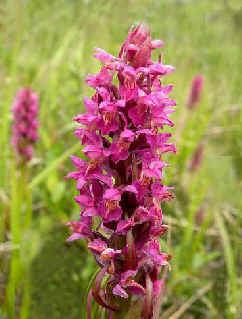
Early Marsh Orchid
- Dacylostalis ringens ______
HK
Genus EPHIPPIANTHUS
- Ephippianthus schmidttii ______
HK
Genus EPIPACTUS
The 35 or so species in EPIPACTUS range
from Europe to Ethiopia, across northern Asia to Japan, and in North
America.
They are terrestrial, usually growing in wet habitats, and with fleshy
rhizomes and leafy stems often reaching a height up to 40
inches.
- Epipactus papillosa ______
HK
Genus EPIPOGIUM
- Epipogium aphyllum ______
HK
Genus GALEARIS
In GALEARIS there are 2 or 3
terrestrial species found in North America and Japan.
The genus is closely related to ORCHIS.
GALEARIS species lack tubers, but they have fleshy roots. They have a
pair of broad leaves, and an erect inflorescence with prominent floral
bracts and several flowers.
- Galearis cyclochila ______
HK
Genus GOODYERA
In GOODYERA there are small
terrestrial species, occurring in the northern Temperate Zone, and in
tropical forests of southeast Asia, Australia, and some Pacific islands.
Most of the species grow in shady conditions on forest floors at low
altitudes.
The plants consist of a creeping rhizome that bends
upward.
- Dwarf Rattlesnake-plantain
______ HK
(NW:388)
Goodyera repens
- Goodyera schlechtendaliana
______ HK
Genus GYMNADENIA
- Gymnadenia camtschatica ______
HK
- Gymnadenia conopsea ______
HK
Genus LIPARIS
In LIPARIS there are about 250 species,
occurring on all continents except Antarctica.
The genus is closely related to MALAXIS.
Species in LIPARIS grow in temperate climates as terrestrials, and in
humid, tropical climates as epiphytes or terrestrials.
The pseudobulb may be below or above ground.
The inflorescence of small flowers are colored red, orange, yellow, or
green.
- Liparis auriculata ______
HK
- Liparis koreana ______
HK
- Liparis krameri ______
HK
- Liparis kumokiri ______
HK
- Liparis purpureovittata ______
HK
Genus LISTERA
Occurring in the northern Temperate Zone, in LISTERA
there are about 25 diminutive and delicate terrestrial species.
As one would walk in a northern woods, near bogs or mossy rocks, a pleasant
and unexpected find of a LISTERA orchid could be had.
If so, the flowers are well worth an inspection with a magnifying glass.
They have a complicated "trigger mechanism" that explodes
the pollinia on the backs of tiny insects.
- Lesser Twayblade ______
IC (BPO:320) (NW:382)
Listera cordata
Listera cordata (var. japonica) ______ HK
Another name for Listera cordata
is Heart-leaf Twayblade.
Although the small species Listera cordata
is one of the most widespread orchids in the world, it is seldom seen.
Its distribution is in northern Europe, Asia, and America.
Growing in wet, mossy woods, its height is up to 10 inches. Its two leaves
are heart-shaped and about a quarter of an inch in diameter at the mid-stem
section.
There are up to 25 green to reddish-purple flowers. The appear during the
summer and persist after pollination has occurred.
- Listera nipponica ______
HK
- Listera pinetorum ______
HK
- Common Twayblade ______ IC
Listera ovata
Genus MALAXIS
-
Malaxis monophyllos ______ HK
Genus MYRMECHIS
- Myrmechis japonica
______ HK
Genus NEOTTIANTHE
- Neottianthe cucullata
______ HK
Genus PIPERIA
- Alaska Piperia ______ AK
(NW:383)
Piperia unalascensis
Another name for Piperia unalascensis
is Slender-spire Orchid.
Genus PLATANTHERA
PLATANTHERA is a terrestrial genus with about
200 species inhabiting temperate regions around the world.
In parts of northern North America, these species are among the most
conspicuous wildflowers in July and August.
Most of the PLATANTHEREA species are in two subgroups:
One, the dilatata/hyperborea complex is usually with white or
green flowers, with a plain, narrow lip. It has a northerly,
transcontinental range in the US and Canada.
The other subgroup are brightly colored fringed orchids, usually with
incised lips. These species extend in North America from Newfoundland to
Texas.
The habitats for PLATANTHERA varies from woods to fields and peat
bogs.
All of the species are erect, and are usually tall and leafy with dense,
many-flowered terminal inflorescences.
The lip is typically long and curved downward. it contains nectar that
attracts pollinating
moths.
- Platanthera chorisiana ______
HK
- White Bog Orchid
______ AK (BPO:456)
(NW:386)
Platanthera dilatata
Other names for Platanthera
dilatata are Leafy White Orchid, Bog Candle, and
Scentbottle.
Where it occurs, the Platanthera dilatata
can bloom en masse in roadside ditches and other places in the summer,
during July.
The plant exceeds 40 inches in height. There are two leaves up to 1 foot
long. The flowers number about 70, each being about an inch in
diameter.
- Tall Green Orchid ______
AK (BPO:457)
Platanthera huronensis
- Northern Green
Orchid ______ AK HK IC
Platanthera hyperborea
- Platanthera mandarinorum
ophrydioides (var. monophylla) ______ HK
Platanthera mandarinorum ophrydioides (var. orerades)
______ HK
- Platanthera metabifolia
______ HK
- Platanthera
sachalinensis ______ HK
- Platanthera takedae
______ HK
- Platanthera tipudoides
nipponica ______ HK
Platanthera tipudoides tipudoides ______ HK
Genus POGONIA
In POGONIA
there are 2 or 3 terrestrial species. One species occurs in eastern North
America. The other two species (below) are in Japan and China.
The separated distribution was caused by glaciers during the Ice Ages, which
caused POGONIA to disappear from the western side of North America.
The plants have fleshy roots and a single leaf.
- Pogonia japonica
______ HK
- Pogonia minor
______ HK
Genus PSEUDORCHIS
- Small-white Orchid
______ IC
Pseudorchis albida
Genus SPIRANTHES
SPIRANTHES is a large
genus of terrestrial orchids with nearly a worldwide distribution, as there
are species of it on all continents except Antarctica.
Most occur in tropical or subtropical areas, but some are in temperate North
America, temperate Asia and Europe.
They have thick, fleshy, tube-like roots, a basal rosette of leaves, and a
tall inflorescence with a few to many small flowers in a spiral form at the
upper part of the inflorescence.
- Hooded Ladies
Tresses ______ AK
(BPO:543) (NW:389)
Spiranthes romanzoffiana
Spiranthes
romanzoffiana has a northern distribution across North
America. Further east, it also occurs in Ireland and the Hebrides Islands.
It occurs in various habitats including bogs and roadsides, with scattered
plants on disturbed ground.
The plant is up to 20 inches tall with several slim, pointed leaves, each
about 10 inches long and two-thirds of an inch wide.
The inflorescence has up to 60 small, creamy flowers, distinguished by their
reflexed lip. Flowering is in the autumn.
Parnassus-grass Family, CELASTRACEAE
A family related to the Saxifrages.
- Grass of Parnassus (or
Bog Star) ______ AK
HK
IC
Parnassia palustris
Parsley
or Celery Family, APIACEAE
- Aegopodium alpestre ______
HK
- Angelica acutiloba ______
HK
Angelica acutiloba lineariloba ______ HK
- Garden Angelica ______ IC(*)
Angelica archangelica
- Wild Celery
______ AK
Angelica lucidaq
- Angelica sachalinensis
(var. sachalinensis) ______ HK
- Wild Angelica ______ IC
Angelica sylvestris
- Angelica ursina
______ HK
- Cow Parsley ______
IC
Anthriscus sylvestris
- Bupleurum ajanense
______ HK
- Bupleurum nipponicum
(var. yesoense) ______ HK
- Caraway ______
IC
Carum carvi
- Poison Water
Hemlock ______ AK
Cicuta mackenzieana
As indicated in
its common name, Cicuta mackenzieana is a poisonous plant.
- Cnidium cnidifolium
______ AK
- Coelopleurum gmelinii
(var. trichocarpum) ______ HK
- Hemlock Parsley
______ AK
Conioselinum chinense
- Conioselinum filicinum
______ HK
- Cow Parsnip
______ AK HK
Heracleum lanatum
- Marsh Pennywort ______
IC
Hydrocotyle vulgaris
- Libanotis coreana
______ HK
- Scots Lovage (or Beach
Lovage) ______ AK IC
Ligusticum scoticum
- Sweet Cicely ______ IC
Myrrhis odorata
- Peucedanum multivittatum
______ HK
- Peucedanum
terebinthaceum ______
HK
- Pleurospermum austriacum
______ HK
Pleurospermum austriacum uralense ______
HK
- Tilingia ajanensis
______ HK
Tilingia ajanensis angustissima ______ HK
- Tilingia holopetala
______ HK
- Tilingia tachiroei
______ HK
Peony Family, PAEONIACEAE
- Paeonia japonica
______ HK
- Paeonia obovata
______ HK
Phlox, or Polemonium
Family, POLEMONIACEAE
- Tall Jacob's
Ladder ______ AK
Polemonium acutiflorum
- Polemonium caeruleum
yesoense (var. yesoense) ______ HK
Polemonium caeruleum yesoense (var. nipponicum) ______ HK
Polemonium caeruleum laxiflorum ______ HK
- Beautiful Jacob's
Ladder ______ AK (NW:412)
Polemonium pulcherrimum
Other names for Polemonium pulcherrimum
include Pretty Jacob's Ladder, Showy Jacob's Ladder, or Showy Polemonium.
Pine Family, PINACEAE
- American Larch (*) ______
AK (ST:39)
Larix laricina
Other names for Larix laricina
are Tamarack and Hackmatack.
- White Spruce (*)
______ AK
(ST:45)
Picea glauca
- Black Spruce (*)
______ AK (ST:48)
Picea mariana
The Black Spruce often hybridizes with the White Spruce (above), and
occasionally the Sitka Spruce (below).
- Sitka Spruce
______ AK(south)
(ST:46)
Picea sitchensis
- Lodgepole Pine ______ AK(southeast)
(ST:19)
Pinus contorta (var. latifolia)
Other names for Pinus contorta
are Tamarack Pine and Scrub Pine.
- Pinus pumila ______
HK
- Western Hemlock
______ AK(south)
(ST:43)
Tsuga heerophylla
- Mountain Hemlock
______ AK(southeast)
(ST:43)
Tsuga mertensiana
Pink,
or Carnation Family, CARYOPHYLLACEAE
- Arenaria arctica
(var. arctica) ______ HK
Arenaria arctica (var. rebunensis) ______ HK
- Arenaria katoana
______ HK
- Arenaria macrocarpa
(var. yezoalpina) ______
HK
- Arenaria
merckioides (var. merckioides) ______ HK
Arenaria merckioides (var. chokaiensis) ______ HK
- Arctic Sandwort ______ IC
(Note: the same common name as for Minuartia arctica)
Arenaria norvegica
- Arenaria verna
(var. japonica) ______ HK
- Alpine Mouse-ear (ph)
______ IC(*)
Cerastrium alpinum

Alpine Mouse-ear
(photo courtesy of Gerin Hood, during the FONT June 2009 Iceland Tour)
- Arctic Mouse-ear ______ IC
Cerastrium arcticum
- Mouse-ear
Chickweed ______ AK
Cerastrium arvense
Cerastrium arvense (var. mitsumorense) ______ HK
- Starwort Mouse-ear ______
IC
Cerastrium cerastoides
- Common Mouse-ear ______
IC
Cerastrium fontanum
- Smooth Mouse-ear ______
IC
Cerastrium glabratum
- Sticky Mouse-ear ______
IC
Cerastrium glomeratum
- Dianthus superbus
(var. speciosus) ______
HK
- Sea Sandwort (ph) ______
IC(*)
Honckenya peploides
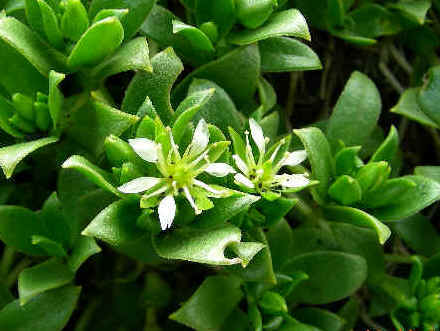
Sea Sandwort
(photo courtesy of Gerin Hood, during the FONT June 2009 Iceland tour)
- Alpine Catchfly
______ IC
Lychnis alpina
- Ragged Robin
______ IC
Lychnis flos-cuculi
In Iceland, the Ragged Robin is in the south. It is rare elsewhere.
- Arctic Sandwort ______ AK
(Note: the same common name as for Arenaria norvegica)
Minuartia arctica
- Two-flowered
Sandwort ______ IC
Minuartia biflora
- Mountain Sandwort
______ IC
Minuartia rubella
- Teesdale Sandwort
______ IC
Minuartia stricta
- Grove Sandwort
______ AK
Moehringia lateriflora
- Tufted Pearlwort
______ IC
Sagina caespitosa
- Snow Pearlwort
______ IC
Sagina nivalis
- Knotted Pearlwort
______ IC
Sagina nodosa
- Procumbent Pearlwort
______ IC
Sagina procumbens
- Alpine Pearlwort
______ HK IC
Sagina saginoides
- Heath Pearlwort
______ IC
Sagina subulata
- Moss Campion (ph) ______
AK(*)
IC(*) (NW:196)
Silene acaulis
Another name for Silene acaulis
is Cushion-pink.

Moss Campion
(photo courtesy of Gerin Hood, during the FONT June 2009 Iceland
tour)
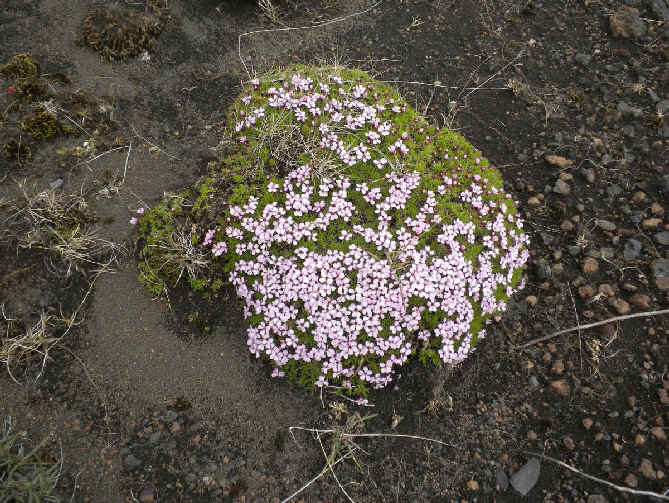
- Silene hidaka alpina ______
HK
- Silene repens (var. apoiensis)
______ HK
Silene repens (var. latifolia) ______ HK
- Silene stenophylla ______
HK
- Silene tokachiensis ______
HK
- Sea Campion (ph) ______
IC(*)
Silene uniflora
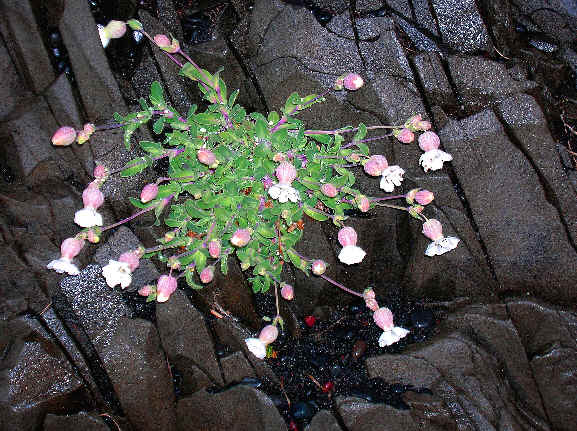
Above & below: Two
photos of Sea Campion
(Both taken during FONT Iceland Tours
upper photo in June 2006 by Cheryl Pearce; lower photo in June 2009 by
Gerin Hood)
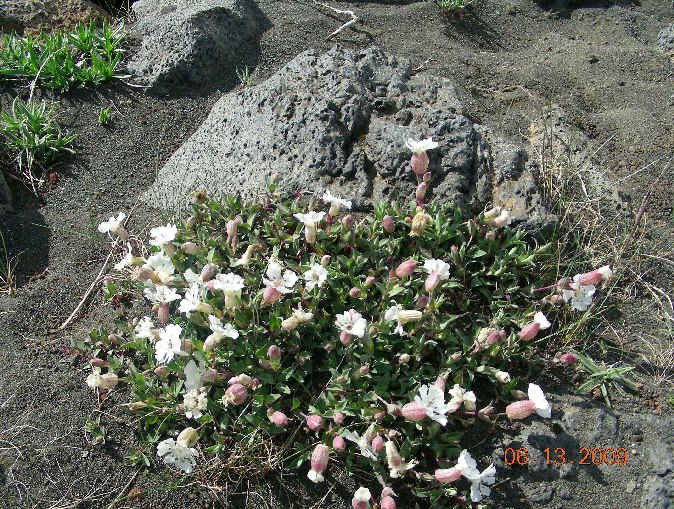
- Corn Spurry
______ IC
Spergula arvensis
- Lesser Spurry
______ IC
(NW:192:for genus)
Spergularia marina
- Northern
Stitchwort ______ HK IC(rare)
Stellaria calycantha
- Fleshy Stichwort
______ IC
Stellaria crassifolia
- Lesser
Stitchwort ______ IC
Stellaria graminea
In Iceland, the Lesser Stitchwort is one of the recent aliens. It has spread
quickly through the Icelandic countryside in the last few decades.
- Low Stitchwort
______ IC
Stellaria humifusa
- Common Chickweed
______ IC
(NW:577)
Stellaria media
MEDICINAL USE:
entire plant in flower
Common Chickweed is used mostly as a skin ointment against various
types of inflammation, ulcers, and eczema.
The herb is especially useful to relieve itching.
Chickweed is used internally to treat rheumatism. The procumbent
stalks can be used to treat illnesses caused by liver disorders and for gall
stones.
AN EDIBLE PLANT: Chickweed makes a healthy addition to
salads.
- Stellaria nipponica
(var. yezoensis) ______ HK
- Stellaria pterosperma
______ HK
- Stellaria ruscifolia
______ HK
Plantain Family,
PLANTAGINACEAE
includes the former
GLOBULARIACEAE, the Globe Daisies
- Lagotis glauca
______ HK
- Lagotis takedana
______ HK
- Lagotis yesoensis
______ HK
- Shoreweed ______
IC
Littorella uniflora
- Ribwort Plantain ______
IC (NW:591)
Plantago lanceolata
Plantago
lanceolata is also called English Plantain.
- Greater Plantain ______ IC
(NW:591)
Plantago major
Plantago
major is also called Common Plantain.
- Sea Plantain ______
IC
Plantago maritima
- Pseudolysimachion
kiusianum miyabei (var. japonicum) ______ HK
- Pseudolysimachion
schmidtianum (var. schmidtianum) ______ HK
Pseudolysimachion schmidtianum (var. yeso-alpinum) ______ HK
Polypod Fern Family, POLYPODIACEAE
- Crypsinus veitchii
______ HK
Polypody Family,
POLYPODIACEAE
- Common Polypody ______ IC
Polypodium vulgare
MEDICINAL
USE: the rhizome
Common Polypody is mostly used as a mild laxative. The rhizome is
said to have a positive effect on persistent skin conditions, and is
considered useful against mycosis, both dermal and in the digestive
system.
It is also used to expel persistent phlegm from the respiratory tract and as
a treatment for hoarseness and dry coughs.
Smaller does are required for children.
Pondweed
& Horned
Pondweed Familes, POTAMOGETONACEAE
and ZANNICHELLIACEAE
- Red Pondweed ______
IC
Potamogeton alpinus
- Slender-leaved Pondweed ______ IC
Potamogeton filiformis
- Potamogeton fryeri
______ HK
- Various-leaved Pondweed ______
IC
Potamogeton gramineus
- Broad-leaved Pondweed ______
IC
Potamogeton natans
- Perfoliate Pondweed ______
IC
Potamogeton
perfoliatus
- Long-stalked Pondweed ______ IC
Potamogeton praelongus
- Lesser Pondweed ______
IC
Potamogeton pusillus
- Beaked Tasselweed ______
IC(very
rare)
Ruppia maritima
- Horned Pondweed ______ IC
Zannichellia palustris
Poppy Family, PAPAVERACEAE
- Alaska Poppy ______ AK
Papaver alaskanum
- Papaver alboroseum ______
AK
- Papaver fauriei
______ HK
- Papaver macounii
______ AK
- Iceland Poppy ______
AK IC(rare)
Papaver nudicaule
In Iceland, Papaver nudicaule
is an alien in gardens, waste places, and roadsides.
In Alaska, the Iceland Poppy is introduced, where it occurs along
roadsides and in waste areas.
- Arctic Poppy (ph) ______
IC(*) (NW:403)
Papaver radicatum
In Iceland, the Arctic Poppy grows in gravelly areas and scree.
It is common in the area of the western fjords and in the southern part of
eastern Iceland. It is rarer in other parts of the country.
MEDICINAL USE: the flower
The Arctic Poppy is analgesic, astringent, and a sedative. Its
flowers have been used for various pains, and were also recommended for
internal hemorrhaging, especially in the digestive tract.
The flower has also been considered useful for insomniacs.
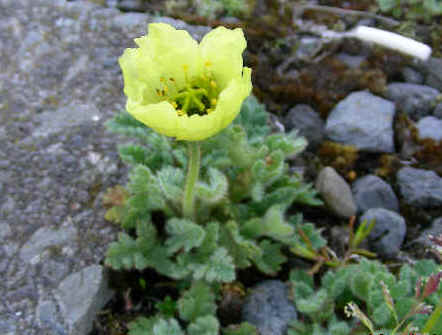
Arctic Poppy
(photo courtesy of Gerin Hood, during the FONT June 2009 Iceland tour)
Primrose Family,
PRIMULACEAE
- Sweet-flower Rock-Jasmine
______ (NW:447)
Androsace chamaejasme (var.
lehmanniana) ______ HK
Another name for Androsace
chamaejasme is Alpine Rock-Jasmine.
- Alpine Bells ______
HK
Cortusa matthioli pekinensis (var. sachalinensis)
- Frigid Shooting Star ______ AK
Dodecatheon frigidum
- Western Shooting Star ______ AK
(NW:447)
Dodecatheon pulchellum
Dodecatheon pulchellum alaskanum
(subspecies in coastal areas of
Alaska that is a shorter plant)
Another name for Dodecatheon pulchellium
is Few-flowered Shooting Star.
- Sea Milkwort
______ IC
(NW:449)
Glaux maritima
- Northern Primrose
______ AK
Primula borealis
- Pixie Eye Primrose
______ AK HK
Primula cuneifolia
Primula cuneifolia (var. cuneifolia) ______ HK
- Greenland Primrose
______ IC(very rare)
Primula egaliksensis
In Iceland, the Greenland Primrose has been found at only one
locality.
- Primula farinosa ______
HK
Primula farinosa (var. matsumurae) ______ HK
Primula farinosa (var. samanimontana) ______ HK
- Primula hidakana ______
HK
Primula hidakana (var. kamuiana) ______ HK
- Primula japonica ______
HK
- Primula jesoana (var. jesoana)
______ HK
Primula jesoana (var. pubescens) ______ HK
- Primula modesta ______
HK
- Primula sorachiana ______
HK
- Strict Primrose
______ IC
Primula stricta
- Primula takedana
______ HK
- Primula yuparensis
______ HK
- Starflower
______ AK HK IC (NW:448)
Trientalis europaea arctica
Another name for Trientalis
europea is Chickweed Wintergreen.
Purslane Family, PORTULACACEAE
- Blinks
______ IC
Montia fontana
Quillwort Family,
ISOETACEAE
- Spring Quillwort ______
IC
Isoetes echinospara
- Quillwort ______
IC
Isoetes lacustris
Rose
Family, ROSACEAE
- Alpine Lady's-mantle (ph)
______ IC(*)
Alchemilia alpina
Alpine Lady's-mantle is found in depressions on slopes, and in snowbeds,
screes, and erosive soil.
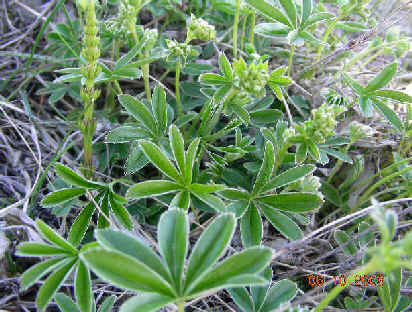
Alpine Lady's-mantle
(photo courtesy of Gerin Hood, during the FONT June 2009 Iceland tour)
- Faeroeic Lady's-mantle ______ IC
Alchemilla faeroensis
In Iceland, Alchemilla faeroensis
is in far-eastern part of the country. Outside Iceland, it is known only in
the Faeroe Islands.
- Alchemia japonica ______
HK
- Common Lady's-mantle ______ IC
Alchemilla vulgaris
The Common Lady's-mantle is divided into several subspecies,
sometimes treated as separate species. Some of them are rather easy to
distinguish
- Serviceberry (or
Juneberry) ______ AK
Amelanchier florida
- Aruncus dioicus
(var. kamtschaticus) ______
HK
- Goatsbeard ______ AK
(NW:473)
Aruncus dioicus (or sylvester)
Other names for Aruncus dioicus
are White Goat's-beard and Bride's Feathers.
- Cerasus nipponica
(var. kurilensis) ______ HK
Cerasus is now said to be a subgenus of Prunus.
- Spring Beauty ______ AK
Claytonia sarmentosa
AN EDIBLE PLANT: Spring Beauty makes a nice addition to salads.
- Siberian Spring Beauty ______
AK
Claytonia sibirica
AN EDIBLE PLANT: Siberian Spring Beauty tastes similar to beet greens.
- Yellow Mountain Avens ______
AK (NW:486)
Dryas drummondii
Another name for Dryas drummondii
is Yellow Dryas.
- Mountain Avens (ph)
______ AK HK IC(*)
(NW:486)
Dryas octopetala
Dryas octopetala (var. asiatica) ______
HK
Another name for Dryas
octopetala is Eight-petaled Avens.
In Iceland, the leafy shoots of Dryas
octopetala, found during all seasons, are called "Rjupnalauf",
meaning "ptarmigan leaves".
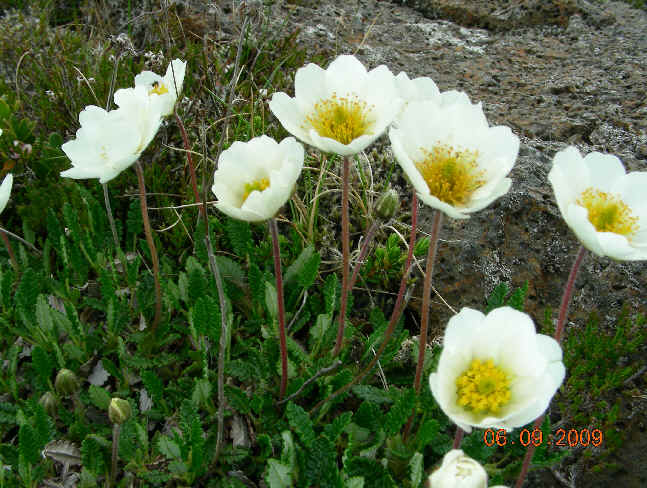
Mountain Avens
(photo courtesy of Gerin Hood, during the FONT June 2009 Iceland tour)
- Filipendula camtschatica ______
HK
- Filipendula glaberrima ______
HK
- Meadowsweet ______ IC
(NW:594)
Filipendula ulmaria
Another name for Filipendula ulmaria
is Queen-of-the-Meadow.
- Beach Strawberry ______ AK
(NW:477)
Fragaria chiloensis
Other names for Fragaria
chiloensis are Coast Strawberry and Sand
Strawberrry.
- Fragaria iinumae ______
HK
- Wild Strawberry (ph) ______
IC (NW:477)
Fragaria vesca
In Iceland, Wild Strawberries mature late (in July), and are usually rather
small. When favorable conditions occur on fertile, sunny slopes, they ripen
fully and are used for human consumption, being tastier than the larger,
cultivated strawberries.
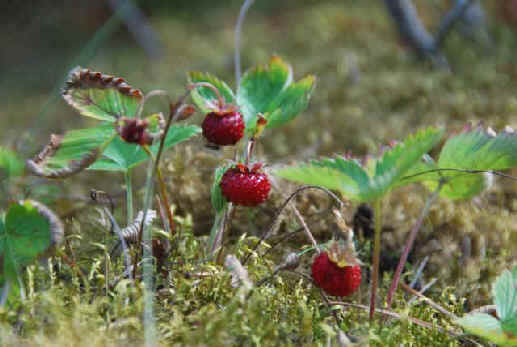
Wild Strawberry
- Wild Strawberry ______
AK (NW:477)
Fragaria virginiana
- Caltha Leaf Avens ______ AK
HK
Geum calthifolium
- Large Leaf Avens ______ AK
(NW:484)
Geum macropyllum macrophyllum
Geum macropyllum perincisum (subspecies in eastern & central
Alaska)
Geum macropyllum
is also called Big-leaf Avens.
- Geum (or
Sieversia) pentapetala
______ HK
- Water Avens ______ IC
(NW:485)
Geum rivale
Another name for Geum rivale
is Purple Avens.
- Ross Avens
______ AK (NW:485)
Geum rossii
Another name for Geum
rossii is Alpine Avens.
- Partridge-foot
______ AK
(NW:474)
Luetkea pectinata
Another name for Luetkea
pectinata is Alpine Spiraea.
- Silverweed ______
AK IC
Potentilla anserina anserina
Potentilla anserina egedii
______ Seaside Silverweed
In Alaska, Potentilla anserina
is an introduced species.
- Alpine Cinquefoil (ph)
______ IC(*)
Potentilla crantzii
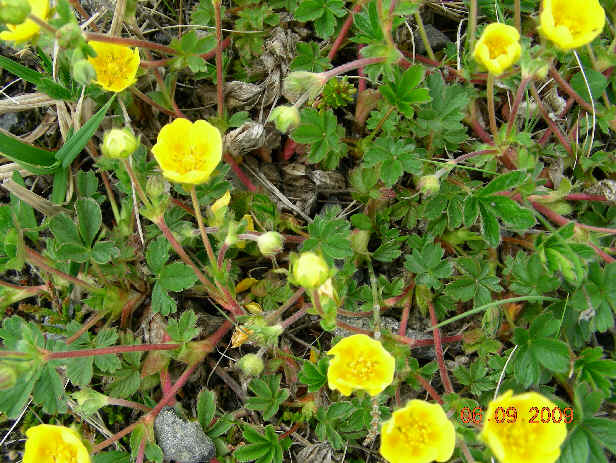
Alpine Cinquefoil
(photo courtesy of Gerin Hood, during the FONT June 2009 Iceland
tour)
- Potentilla dickinsii ______
HK
- Beach Cinquefoil (or Pacific
Silverweed) ______ AK
Potentilla egedii grandis
- Tormentil ______
IC(very
rare)
Potentilla
erecta
- Shrubby Cinquefoil (or Tundra
Rose) ______ AK HK
Potentilla fruiticosa
Potentilla fruiticosa (var. arbuscola) ______ HK
- Potentilla matsumurae
______ HK
Potentilla matsumurae (var. apoiensis) ______ HK
Potentilla matsumurae (var. yuparensis) ______ HK
- Potentilla miyabei
______ HK
- Snow Cinquefoil (or Snow
Potentilla) ______ AK
HK (NW:478)
Potentilla nivea
Potentilla nivea (var. yuparensis) ______ HK
- Norwegian
Cinquefoil ______ AK (NW:478)
Potentilla norvegica
Another name for Potentilla
norvegica is Rough Cinquefoil.
- Marsh Cinquefoil
______ AK HK IC
Potentilla palustris (or Comarum palustre)
Another name for the Marsh Cinquefoil
is Marsh Fivefinger.
- One-flowered
Cinquefoil ______ AK
Potentilla uniflora
- Rosa acicularis
______ HK
- Prickly Rose
______ AK
Rosa acicularis
- Glaucous Dog-rose
______ IC
Rosa dumalis
- Nootka Rose
______ AK
Rosa nutlatensis
- Burnet Rose
______ IC
Rosa pimpinellifolia
- Nagoonberry ______
AK (NW:488)
Rubus arcticus
The fruits of the Nagoonberry are
dark red or purplish.
- Cloudberry ______
AK HK
Rubus chamemorous
Other names for Rubus
chamemorous are Baked Appleberry and
Salmonberry.
Salmonberry is a name used by Alaska native people for this species, but
true Salmonberry is Rubus spectabilus
(below).
In Alaska, berries of the Cloudberry ripen from August to
September.
- Trailing Raspberry ______ AK
HK (NW:488)
Rubus pedatus
Another name for Rubus pedatus
is Strawberry Bramble.
- Rubus pseudojaponicus
______ HK
- Stone Bramble
______ IC
Rubus saxatilis
- Rubus vernus
______ HK
- Canadian Burnet ______
HK (NW:473)
Sanguisorba canadensis
Sanguisorba canadensis (var. riishiriensis) ______ HK
- Sanguisorba japonensis
______ HK
- Sanguisorba longifolia
______ HK
- Great Burnet
______ IC (NW:473)
Sanguisorba officinalis
- Sanguisorba
poroshiriensis ______
HK
- Sitka Burnet
______ AK
Sanguisorba stipulata
- Sanguisorba tenuifolia
______ HK
Sanguisorba tenuifolia (var. grandiflora) ______ HK
- Creeping Sibbaldia
______ IC
(NW:482)
Sibbaldia procumbens
- Rowan ______ IC
Sorbus aucuparia
- Sorbus matsumurana
______ HK
- Sorbus sambucifolia
______ HK
Sorbus sambucifolia (var. pseudogracilis) ______ HK
- Mountain Ash
______ AK
Sorbus sitchensis
- Alaska Spiraea (or
Beauverd's Spiraea) ______ AK
Spiraea beauverdiana
AN EDIBLE PLANT:
The leaves of Alaska Spiraea can be brewed into a tea.
- Birch-leaf Spirea ______ HK
(NW:472)
Spiraea betulifolia
Spiraea betulifolia (var. aemiliana) ______ HK
- Spiraea media
(var. sericea) ______ HK
- Spiraea miyabei
______ HK
Rush Family, JUNCACEAE
- Alpine Rush ______ IC
Juncus alpinus
- Iceland Rush ______
IC
Juncus arcticus
intermedius
- Jointed Rush ______ IC
Juncus articulatus
- Juncus beringensis ______
HK
- Two-flowered Rush ______
IC
Juncus biglumis
- Toad Rush ______
IC
Juncus bufonius
- Bulbous Rush ______ IC
Juncus bulbosus
- Chestnut Rush ______
IC
Juncus castaneus
- Juncus ensifolius
______ HK
- Thread Rush ______
IC
Juncus filiformis
- Saltmarsh Rush ______ IC
Juncus gerardi
- Juncus kamtschatcensis
______ HK
- Juncus mertensianus
______ HK
- Frog Rush ______
IC
Juncus ranarius
- Heath Rush ______ IC(rare)
Juncus
squarrosus
- Juncus triceps
______ HK
- Three-leaved Rush ______
IC
Juncus trifidus
- Three-flowered Rush ______
IC HK
Juncus triglumis
- Curved Wood Rush ______ IC
Luzula arcuata
Luzula arcuata
(var. unalasachkensis) ______
HK
- Heath Wood Rush ______ IC
Luzula multiflora
- Luzula oligantha
______ HK
- Spiked Wood Rush ______ IC
Luzula spicata
- Sudetan Wood Rush ______ IC
Luzula sudetica
Luzula sudetica
(var. nipponica) ______ HK
Sandlewood Family, SANTALACEAE
- Timberberry
______ AK (NW:493)
Geocaulon lividum
Other names for Geocaulon lividum are
Pumpkin Berry, Northern Comandra, and False Toadflax.
- Thesium refractum ______
HK
Saxifrage Family, SAXIFRAGACEAE
In Alaska, there are many similar
Saxifrages that grow in wet areas.
All have edible leaves.
- Boykinia lycoctonifolia ______
HK
- Alaska Boykinia ______ AK
(NW:504)
Boykinia richardsonii
Other names for Boykinia richardsonii
are Bear-flower, Richardson's Boykinia, and Richardson's Brookfoam.
- Smooth Alumroot ______ AK
(NW:500)
Heuchera glabra
Another name for Heuchera glabra
is Alpine Heuchera.
Plants in the following genus, Mitella,
are known as Miterworts, or Bishop's Caps.
- Mitella integripetala
______ HK
- Naked Miterwort ______
HK (NW:497)
Mitella nuda
Other names for Mitella
nuda are Small Bishop's Cap or Bare-stemmed
Bishop's Cap.
- Yellow Mountain Saxifrage ______
IC (NW:509)
Saxifraga aizoides
- Yellow-spotted
Saxifrage ______ AK HK
(NW:507)
Saxifraga bronchialis
Saxifraga bronchialis funstonii (var. rebunshirensis)
______ HK
Other names for
Saxifraga bronchialis are Dotted Saxifrage and Matted
Saxifrage.
- Tufted Saxifrage
______ IC
(NW:508)
Saxifraga caespitosa
The Tufted Saxifrge is often divided into two subspecies:
Saxifraga caespitosa caespitosa
Saxifraga caespitosa decipiens
They are often treated as separate species (Saxifraga caespitosa and
Saxifrga rosacea).
But as a subspecies, Saxifraga caespitosa decipiens has thinner, less
compact clusters of leaf shoots, and large flowers with relatively large
petals.
Saxifraga caespitosa is also
called Tufted Alpine Saxifrage.
- Nodding Saxifrage ______ AK IC
(NW:508)
Saxifraga cernua
Other names for Saxifraa
cernua are Drooping Saxifrage and Bulblet
Saxifrage.
- Pyramidal
Saxifrage ______ IC
Saxifraga cotyledon
- Rusty Saxifrage ______
AK (NW:505)
Saxifraga ferruginea
Another name for Saxifraga
ferruginea is Coast Saxifrage.
- Spider Whiplash Saxifrage
______ AK
(NW:509)
Saxifraga flagellaris
Other names for Saxifraga
flagellaris are Spider Saxifrage, Spider-plant, and Stoloniferous
Saxifrage.
- Saxifraga fortunei
(var. mutabilis) ______
HK
Saxifraga fortunei (var. alpina) ______ HK
- Saxifraga fusca fusca
______ HK
- Meadow Saxifrage
______ IC
Saxifraga granulata
- Yellow Marsh Saxifrage ______
AK IC
(NW:509)
Saxifraga hirculus
Another name for Saxifraga
hirculus is Bog Saxifrage.
- Mossy Saxifrage
______ IC
Saxifraga hypnoides
- Saxifraga japonica
______ HK
- Saxifraga lacinata
______ HK
- Red-stemmed Saxifrage ______ AK
(NW:505)
Saxifraga lyallii
Another name for Saxifraga
lyallii is Lyall's Saxifrage.
- Saxifraga merkii
(var. merkii) ______ HK
- Heart-leaf Saxifrage ______ HK
(NW:505)
Saxifraga nelsoniana
(var. reniformis)
- Saxifrraga nishidae
______ HK
- Alpine Snow
Saxifrage ______ IC
Saxifraga nivalis
- Purple Mountain Saxifrage
______ AK IC (NW:509)
Saxifraga oppositifolia
Saxifraga oppositifolia oppositifolia
(subspecies in Alaska)
Other names for Saxifraga oppositifolia are:
Purple Saxifrage, Twinleaf Saxifrage, or
the French Knot Plant
- Silver Saxifrage
______ IC
Saxifraga paniculata
- Brook Saxifrage ______
AK
Saxifraga punctata
- Alpine Brook
Saxifrage ______ AK IC
(NW:508)
Saxifraga rivularis
Other names for Saxifraga
rivularis are Weak Saxifrage and Pygmy
Saxifrage.
In Iceland, a small reddish
mountain variety of the Alpine Brook Saxifrage, called the Arctic Brook
Saxifrage, Saxifraga hyperborea,
is sometimes said to be a separate species. It is rare in Iceland, usually
above 2,700 feet above sea level.
- Saxifraga sachalinensis ______
HK
- Starry Saxifrage
______ IC
Saxifraga stellaris
- Slender Snow
Saxifrage ______ IC
Saxifraga tenuis
- Prickly Saxifrage
______ AK
(NW:507)
Saxifraga tricuspidata
Another name for
Saxifraga tricuspidata is Three-tooth Saxifrage.
- Tiarella polyphylla
______ HK
Sea Lavender, or
Plumbago Family, PLUMBAGINACEAE
- Thrift (ph) ______
IC(*)
Almeria maritima
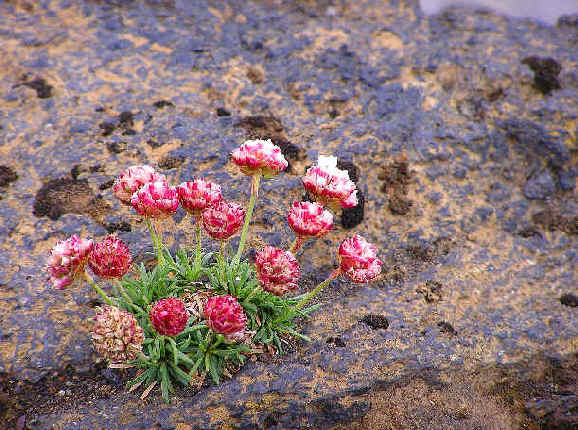
Thrift
(photo by Cheryl Pearce during the June 2006 FONT Iceland
Tour)
Sedge Family,
CYPERACEAE
including here the family
SCHEUCHZERIACEAE
with only the one genus Scheuchzeria
- Baeothryon cespitosum ______
HK
- Carex apoiensis ______
HK
- Black Alpine Sedge ______ IC
Carex atrata
- Bicolored Sedge ______ IC
Carex bicolor
- Stiff Sedge ______ IC
Carex bigelowii
- Carex blepharicarpa ______
HK
Carex blepharicarpa (var. dueensis) ______
HK
- Brownish Sedge ______
IC(rare)
HK
Carex brunnescens
- Carex canescens ______
HK
- Hair Sedge ______ IC HK
Carex capillaris
- Capitate Sedge ______
IC
Carex capitata
- String Sedge ______ IC
Carex chordorrhiza
- White Sedge ______ IC
Carex curta
- Common Yellow Sedge ______ IC
Carex demissa
- Dioecious Sedge ______
IC
Carex dioeca
- Carex doenitzii ______
HK
- Star Sedge ______ IC
Carex echinata
- Carex eleusinoides ______
HK
- Glaucous Sedge ______
IC
Carex flacca
- Large Yellow Sedge ______ IC(rare)
Carex flava
- Carex flavocuspis ______
HK
Carex flavocuspis (var. rishirensis) ______ HK
- Glacier Sedge ______ IC
Carex glacialis
- Carex hakkodensis ______
HK
- Hudson Bay Sedge ______ IC(rare)
Carex heleonastes
- Carex kabanovii ______
HK
- Porsild's Sedge ______ IC
Carex krausei
- Hare's-foot Sedge ______
IC HK
Carex lachenalii
- Common Bog Sedge ______
IC HK
Carex limosa
- Livid Sedge ______
IC HK
Carex livida
- Lyngbye's Sedge ______ IC
HK
Carex lyngbyei
In Iceland, Carex
lyngbyei is one of the few western species in Icelandic
flora, unknown on the European continent.
- Norway Sedge ______ IC
Carex mackenziei
- Thick-headed Sedge ______ IC
Carex macloviana
- Tall Bog Sedge ______
IC
Carex magellanica
- Curved Sedge ______
IC
Carex maritima
- Carex melanocarpa ______
HK
- Carex mertensii ______
HK
- Carex michauxiana ______
HK
- Short-stalk Sedge ______ AK
Carex microchaeta
-
Bristle Sedge ______ IC
Carex microglochin
- Carex middendorffii
______ HK
- Nard Sedge ______
IC
Carex nardina
- Common Sedge ______ IC
Carex nigra
- Close-headed Alpine Sedge
______ IC
Carex norvegica
- Carex oxyandra
______ HK
- Pale Sedge ______
IC(rare)
Carex pallescens
Carex pallescens
has only been found at 2 locations in Iceland.
- Carnation Sedge ______
IC
Carex panicea
- Carex pauciflora
______ HK
- Carex paupercula
______ HK
- Pill Sedge ______ IC
Carex pilulifera
- Flea Sedge ______
IC
Carex pulicaris
- Carex rapestris
______ HK
- Mountain Bog Sedge ______
IC
Carex rariflora
- Carex rhynchophysa
______ HK
- Carex rotundata
______ HK
- Bottle Sedge ______ IC
Carex rostrata
Carex rostrata (var,
rostrata) ______ HK
- Red Sedge ______ IC
Carex rufina
- Rock Sedge ______ IC
Carex rupestris
- Saltmarsh Sedge ______ IC
Carex salina
- Russet Sedge ______ IC
Carex saxatilis
- Carex schmiditii
______ HK
- Small-fruited Yellow Sedge
______ IC
Carex serotina
- Carex stenantha
(var. taisetsuensis) ______ HK
- Hoppner Sedge ______ IC
Carex subspathacea
- Carex subumbellata
(var. subumbellata) ______ HK
Carex subumbellata (var. verecunda) ______ HK
- Carex stylosa
______ HK
- Carex tenuiformis
______ HK
- Carex traiziscana
______ HK
- Carex tschonoskii
______ HK
- Sheathed Sedge ______ IC
HK
Carex vaginata
- Carex vanheurckii
______ HK
- Carex vesicaria
______ HK
- Needle Spike-rush ______ IC
Eleocharis acicularis
- Eleocharis mamillata
(var. cyclocarpa) ______
HK
- Common Spike-rush ______ IC
Eleocharis palustris
- Eleocharis mamillata
______ HK
- Few-flowered Spike-rush ______
IC
Eleocharis
quinqueflora
- Slender Spike-rush ______ IC
Eleocharis uniglumis
- Common Cottongrass ______ IC(*)
Eriophorum
angustifolium
- Alaska Cotton (ph) ______
AK(*) IC(*)
Eriophorum scheuchzeri
Eriophorum scheuchzeri (var. tenuifolium) ______ HK
Another name for Eriophorum scheuchzeri
is Scheuchaer's Cottongrass.
The name Alaska Cotton of course applies to the plant in Alaska.
In Iceland, its Icelandic name is Hrafnafifa.
Eriophorum scheuchzeri has been seen
during FONT tours in both Alaska and Iceland.
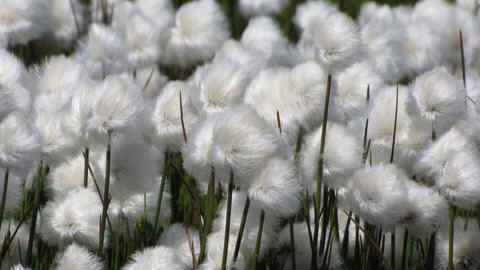
Alaska Cotton, known in Iceland as Hrafnafifa
photographed during a FONT tour in Iceland in June 2012
(photo by Gabi Hauser)
- Eriophorum vaginatum
(var. fauriei) ______
HK
- Kobresia bellardii
______ HK
- Bellard's Kobresia ______ IC
Kobresia myosuroides
- Rhynchospora alba
______ HK
- Rannoch-rush, or Pod
Grass ______ HK
Scheuchzeria
palustris
- Scirpus maximowiczii
______ HK
- Trichophorum alpinum
______ HK
- Deergrass ______ IC
Trichophorum
caespitosum
Snakeberries, in the Family
ASPARGACEAE
often included in LILIACEAE
- Maianthemum bifolium
______ HK
- Snakeberry
______ AK HK
(NW:303)
Maianthemum
dilatatum
Other names for Maianthemum dilatatum
are False Lily-of-the-Valley and Two-leaved False Solomon's-seal.
Soapberry Family, SAPINDACEAE
now including the Maples, long
placed in their own family ACERACEAE
- Butterfly Maple ______ HK
Acer tschonoskii
- Acer ukurunduense
______ HK
Spikemoss Family, SELAGINELLACEAE
- Lesser Clubmoss ______
HK IC
Selaginella
selaginoides
Spleenwort, or Bird's-nest Fern Family, ASPLENIACEAE
- Asplenium
ruta-muraria ______ HK
- Forked Spleenwort ______ IC
Asplenium septentrionale
- Maidenhair Spleenwort ______ IC
Asplenium trichomanes
- Green Spleenwort ______ HK
IC
Asplenium viride
Spurge Family,
EUPHORBIACEAE
- Euphorbia tsukamotoi
______ HK
Staff-vine,
or Bittersweet Family, CELASTRACEAE
- Euonymus tricarpus
______ HK
Starwort
Family, CALLITRICHACEAE
- Peduncled Water-starwort ______
IC
Callitriche brutia
- Hook-tipped Water-starwort
______ IC
Callitriche hamulata
- Autumn Water-starwort ______
IC
Callitriche
hermaphroditica
- Vernal Water-starwort _______
IC
Callitriche palustris
- Common Water-starwort ______ IC
Callitriche stagnalis
St. John's Wort Family,
HYPERICACEAE
has been part of the
Garcinia Family, CLUSIACEAE
- Hypericum kamtschaticum
______ HK
- Hypericum samaniense
miyabei ______ HK
- Hypericum yesoenze
______ HK
- Hypericum yojiroanum
______ HK
Stonecrop Family, CRASSULACEAE
-
Pigmyweed ______ IC(very rare)
Crassula aquatica
- Hylotelephium cauticola
______ HK
- Hylotelephium pluricaule
______ HK
Hylotelephium pluricaule ezawae ______ HK
- Hylotelephium
verticillaum ______ HK
- Phedimus kamtschaticus
______ HK
Phedimus kamtschaticus (var. floribundus) ______ HK
- Rhodiola ishidae
______ HK
- Roseroot (ph) ______
HK IC(*)
Rhodiola rosea
As Roseroot can not survive continuous grazing, in Iceland it is
usually found in steep cliffs, gorges, or lake islands not accessible by
sheep.
The plant is very much favored by sheep (so common in Iceland), and
so it is easily exterminated from pastures except on inaccessible rock
ledges.
Where land has been protected from grazing, or has had moderate or
discontinuous grazing for several decades, Roseroot may be found in
fertile heathland and on slopes.

Roseroot
(photo courtesy of Gerin Hood, during the FONT June 2009 Iceland tour)
- Moss Stonecrop ______ IC
(NW:580)
Sedum acre
Other names for Sedum acre
are Common Stonecrop, Biting Stonecrop, Golden-carpet, Wallpepper.
By whatever name, in Iceland, it is common everywhere, growing in
gravelly, rocky, and sandy areas.
MEDICINAL USE: the fresh plant before
flowering, except the root. It has little or no effect after drying.
Moss, or Common Stonecrop is considered useful to treat warts
and corns, on which a poultice would be placed 3 or 4 times daily.
The herb can also be useful for sores that are slow to heal. A weak infusion
or liniment of the plant is best for sores.
Stonecrop is only to be used externally. It can cause vomiting or
diarrhea if taken internally. Externally, it can irritate the skin, causing
a rash and blisters.
- Annual Stonecrop ______ IC
Sedum annuum
- Sedum japonicum
japonicum (var. senanense) ______ HK
- Roseroot
______ AK
Sedum rosea
Other names for Sedum rosea are Rosewort and King's Crown.
- Hairy Stonecrop (ph)
______ IC(*)
Sedum villosum
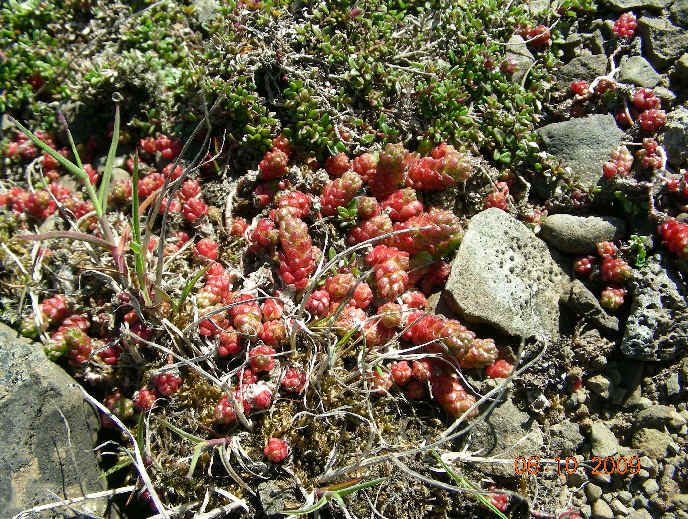
Hairy Stonecrop
(photo courtesy of Gerin Hood, during the FONT June 2009 Iceland
tour)
Sundew Family,
DROSERACEAE
- Drosera anglica ______
HK
- Drosera obovata ______
HK
- Round-leaved Sundew (ph) ______
HK IC (NW:215)
Drosera rotundifolia
Drosera rotundifolia is also
called
Common Sundew.
Drosera rotundifolia grows in marshlands and fens. In
Iceland, it is very rare, found mainly in the west and north.
MEDICINAL USE: the whole plant, except
the root
Round-leaved, or Common Sundew contains antibacterial
substances that are thought to be effective against various bacteria causing
colds and bronchitis.
It can relieve convulsive coughing spells, and it has been successfully used
to treat whooping cough.
It can also be useful for asthma and dry, tickling coughs.
It is recommended that the herb be used when a cold begins, especially if
accompanied by a dry, irritating cough, in order to prevent subsequent
bacterial infection.
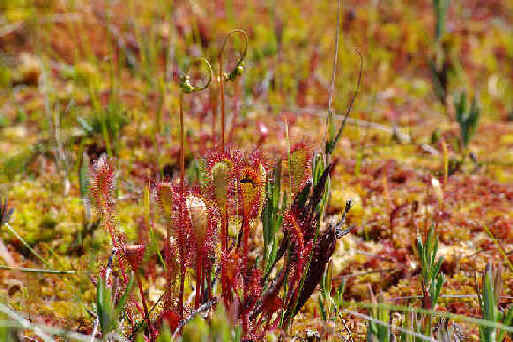
Round-leaved Sundew, Drosera rotundifolia
Teasel Family,
DIPSACACEAE
- Field Scabious ______ IC
Knautia arvensis
In Iceland, Field Scabious
is introduced in only a few places.. It is rare.
- Scabiosa
japonica (var. acutiloba) ______ HK
- Devil's-bit Scabious ______
IC
Succisa pratensis
Valerian Family,
VALERIANACEAE
- Patrinia gibbosa
______ HK
- Patrinia sibirica
______ HK
- Capitate Valerian ______ AK
Valeriana capitata
- Valeriana fauriei
______ HK
- Common Valerian ______ IC
Valeriana officinalis
- Hill Valerian ______
IC
Valeriana sambucifolia
In Iceland, possibly all natural valerians are Valeriana
sambucifolia, but
the separation of it from Valeriana officinalis appears "rather
vague".
- Sitka Valerian ______ AK
(NW:553)
Valeriana sitchensis
Violet Family, VIOLACEAE
- Western Dog Violet ______ AK
(NW:559)
Viola adunca
- Viola alliariifolia
______ HK
- Viola biflora ______
AK HK
- Viola blandaeformis
______ HK
- Viola brevistipulata
brevistipulata ______ HK
Viola brevistipulata brevistipulata (var. laciniata)
______ HK
Viola
brevistipulata hidakana ______ HK
Viola brevistipulata hidakana (var. yesoana) ______ HK
- Heath Dog-violet
______ IC
Viola canina
- Viola collina
______ HK
- Viola crassa
borealis ______
HK
- Northern Marsh
Violet ______ AK IC
Viola epipsila
- Viola epipsiloides
______ HK
- Stream Violet
______ AK (NW:557)
Viola glabella
Another name for Viola
glabella is Pioneer Violet.
- Viola hultenii
______ HK
- Viola kamtschadalorum
______ HK
- Viola kitamiana
______ HK
- Alaska Violet
______ AK
Viola langsdorfii
- Alpine Marsh
Violet ______ IC
Viola palustris
- Wood Violet
______ AK
Viola rentifolia
- Common Dog-violet
______ IC(rare)
Viola riviniana
- Viola sacchalinensis
______ HK
- Selkirk's Violet
______ AK HK
Viola selkirkii
- Wild Pansy
______ IC (NW:600)
Viola tricolor
Another name for Viola tricolor
is Johnny-jump-up.
- Viola variegata
______ HK
- Viola yubariana
______ HK
Water Lily Family, NYMPHAEACEAE
- Yellow Pond
Lily ______ AK
(NW:356)
Nuphar polysepala
Another name for Nuphar polysepala
is Indian Pond Lily.
- Nuphar pumila
(var. pumila) ______ HK
Nuphar pumila (var. ozensis) ______ HK
- Nymphaea tetragona
(var. angusta) ______ HK
Nymphaea tetragona (var. erythrostigmatica) ______ HK
Water-milfoil Family, HALORAGACEAE
- Alternate Water-milfoil ______ IC
Myriophyllum
alterniflorum
- Spiked Water-milfoil ______ IC(rare)
Myriophyllum
spicatum
Willow Family, SALICACEAE
This family includes trees: Aspens,
Cottonwoods, Poplars.
- Balsam Poplar (*) ______ AK
(ST:236)
Populus balsamifera
- European Aspen (*) ______
IC (ST:231)
Populus tremula
- Quaking Aspen (*)
______ AK
(ST:230)
Populus tremuloides
- Black Cottonwood
______ AK(southeast)
(ST:237)
Populus trichocarpa
Willows (in the genus Salix)
hybridize quite easily making identification difficult.
- Alaska Willow (or
Felt Leaf Willow) ______ AK
Salix alaxensis
- Arctic Willow
______ AK
Salix arctica
- Bluish Willow ______
IC
Salix callicarpaea
- Salix fuscescens
______ HK
- Dwarf Willow (ph) ______
IC(*)
Salix herbeacea
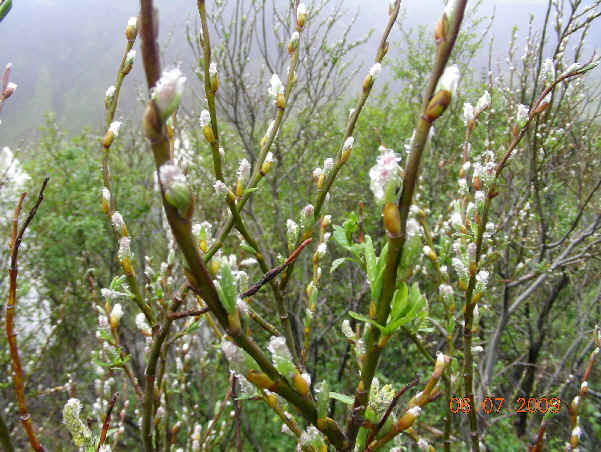
Dwarf Willow
(photo courtesy of Gerin Hood, during the FONT June 2009 Iceland
tour)
- Woolly Willow (ph)
______ IC(*)
Salix lanata
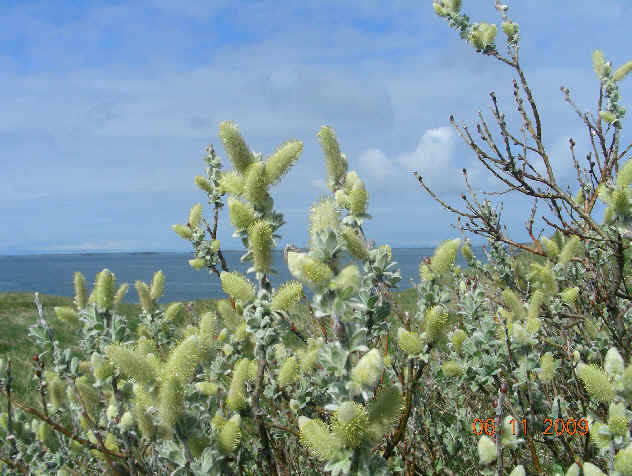
Wooly Willow
(photo courtesy of Gerin Hood, during the FONT June 2009 Iceland
tour)
- Salix nakamurana nakamurana
______ HK
- Salix nummularia ______
HK
- Skeleton Leaf Willow ______
AK
Salix phlebophylla
- Tea-leaved Willow ______ IC
Salix phylicifolia
- Salix reinii
______ HK
- Round-leaf Willow
______ AK
Salix rotundifolia
- Salix yesoalpina
______ HK
Salix yesoalpina (var. neoreticulata) ______ HK
Salix yesoalpina kurilensis ______ HK
Willowherb, or Rosebay, or Evening Primrose Family, ONAGRACEAE
- Small Enchanter's Nightshade
______ HK
(NW:370)
Circaea alpina
Another name for Circea alpina
is Alpine Enchanter's Nightshade.
- Chickweed Willow-herb
______ IC
Epilobium alsinifolium
- Epilobium amurense
cephalostigma ______ HK
- Alpine Willow-herb ______
HK IC
Epilobium anagallidifolium
- Rosebay Willow-herb (or Common
Fireweed) ______ AK
HK IC (NW:362)
Epilobium
(now Chamerion) angustifolium
Chamerion angustifolium angustifolium (subspecies in Alaska)
Other names for Chamerion angustifolium
are Great Willow-herb and Narrow-leaved Fireweed.
- Cliff Willow-herb
______ IC
Epilobium collinum
- Epilobium fauriei
______ HK
- Hornemann's Willow-herb
______ HK IC
Epilobium hornemanni
- White-flowered Willow-herb
______ HK IC
(NW:360)
Epilobium lactiflorum
Another name for
Epilobium lactiflorum is Milky Willow-herb.
- Arctic Riverbeauty
______ IC
(NW:362)
Epilobium (now Chamerion) latifolium
Other names for Epilobium latifolium are
Broad-leaved Willow-herb, Broad-leaved Fireweed, Dwarf Fireweed, or simply River
Beauty.
- Broad-leaved Willow-herb
______ IC
Epilobium montanum
In Iceland, the Broad-leaved Willow-herb is a very rare alien.
- Marsh Willow-herb
______ IC
Epilobium palustre
- American Willow-herb
______ IC
Epilobium watsonii
Wintergreen Family, PYROLACEAE
PYROLACEAE is now said to
be a subfamily in the Heath Family, ERICACEAE
- One-flowered Wintergreen ______
AK HK (NW:451)
Moneses uniflora
Other names for Moneses uniflora
are Wood-nymph, Wax Flower, Single Delight, and Shy Maiden.
- Pyrola alpina
______ HK
- Pink Pyrola (or
Wintergreen)
______ AK HK
Pyrola asarifolia
Pyrola asarifolia incarnata ______ HK
- Pyrola faurieana
______ HK
- Arctic Wintergreen
______ AK IC(*)
Pyrola grandiflora
Another name for Pyrola
grandiflora is Large-flowered Wintergreen.
In Iceland, Arctic Wintergreen
is widespread in the north and northeast.
MEDICINAL USE:
the leaves
Wintergreen is considered effective to relieve pain and inflammation
in the digestive tract.
It has also been used for pain in the urinary tract, especially pain
resulting from kidney stones.
It is thought to have a strengthening effect on the womb.
Wintergreen is effective on wounds, and a tea or ointment of the herb
is used for many types of eczema or sores which are slow to heal.
A weak infusion of the leaves is considered a good wash for sensitive or
swollen eyes.
- Lesser Wintergreen
______ HK IC (NW:452)
Pyrola minor
Another name for Pyrola minor
is Lesser Wintergreen.
- Pyrola renifolia
______ HK
- Serrated
Wintergreen ______ AK HK IC
(NW:452)
Orthilia secunda
The Serrated Wintergreen has been said to be Pyrola
secunda. Other names for it are One-sided Wintergreen,
One-sided Shinleaf, and Sidebells.
Wood-sorrel Family, OXALIDACEAE
- Wood-sorrel
______ HK IC(very rare)
Oxalis acetosella
To
Top of Page



 Wildflowers
Wildflowers ![]()











































![]()